#Sen Toku
Explore tagged Tumblr posts
Text

ya boy likes watching shows
Up to date toku watched list 📺
Currently Watching:
the currently watching list is where shows come to die. If I put a show here I will NOT finish it. This list is cursed.
Gozyuger 🐺🦁🦖🦅🦄
Sentai (in watched order):
Kyuranger
Kyoryuger
Kiramager
Gekiranger
Go-Onger☆
ToQger
Magiranger
Zyuohger
Boukenger
Hurricaneger
Kakuranger
Megaranger
Carranger
Liveman
Gingaman☆
Gaoranger
GoGoV
Bioman
Fiveman
Dairanger
Changeman☆ (lb for second rewatch)
King Ohger
Dynaman
Goggle V☆
Flashman
Denziman
Sun Vulcan
Battle Fever J
JAKQ
Goseiger
Ohranger
Boonboomger
☆ - the big 4. Peak fiction. The best ones
every ranger from kyu to denzi ❤️❤️❤️
Kamen Rider:
Ghost
Zero One
Amazon
Amazons (S1)
Hibiki
Blade
Power Rangers (chronological + completely finished):
MMPR
Alien Rangers
In Space
Lost Galaxy
Ninja Storm
SPD
Mystic Force
Operation Overdrive
Jungle Fury
RPM
Dino Charge
Dino/Cosmic Fury
Metal Heroes:
Choujinki Metalder (😭😭😭😭😭😭😭😭😭😭😭😭)
Uchuu Keiji Gavan + next gen movies
Uchuu Keiji Sharivan + next gen movie
Sekai Ninja Sen Jiraiya
i'm gonna put Kikaider here. feels right.
Ultraman
Orb
Misc/Specials:
The Highschool Heroes
Strongest Battle
Kanpai Senshi After V
Chosoku ParaHero GandD
Thunderbirds (1965)

19 notes
·
View notes
Text
The Chanoyu Hyaku-shu [茶湯百首], Part IV: Poem 79.

〽 Akatsuki ha sukiya no uchi mo andon ni yo-kai nado ni ha tankei wo oke
[曉は 數奇屋 の內も行燈に 夜會な���には短檠を置け].
“Dawn [is the time] when, within the sukiya, the andon [should be used]; but at night-gatherings and the like, the tankei is placed out.”

Once again, referring to ideas that have already been touched on in the previous posts, Jōō is reinforcing the tradition that a tomoshibi sequestered within a zashiki-andon should be used as the principal source of artificial illumination in the sukiya [數奇屋]¹ at chakai held early in the morning².
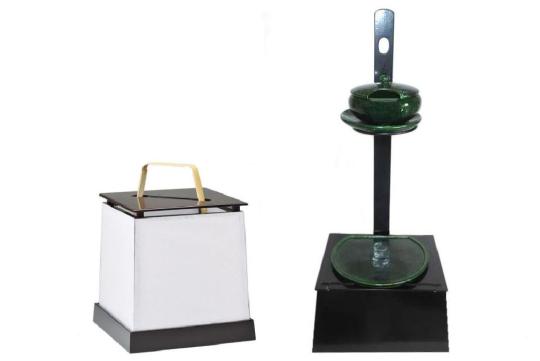
But at night, the tomoshibi should be placed on a tankei, so that its unobstructed light will be able to flood the whole room with its warming glow.

Aside from the fact that Jōō uses the word asa [朝] (morning), rather than akatsuki [曉] (dawn), in his (original) version of this poem³, there are no other differences between what is found in any of the collections, reflecting the uniformity of the understanding of this teaching -- that the zaseki-andon should be used at dawn, and the tankei at night.
_________________________
¹While the Kyūshū manuscript spells sukiya phonetically (as sukiya [すきや]*), the other versions (except for Katagiri Sadamasa’s) use the Korean kanji-form sukiya [數奇屋].
Sekishū’s version has sukiya [數寄屋], using the “Japanese” form of the word† that began to appear after the middle of the seventeenth century (at the time when the Japanese, under the influence of Kanamori Sōwa’s [金森宗和; 1584 ~ 1657] highly speculative histories‡ of chanoyu in Japan, were actively trying to distance chanoyu from its Korean roots). ___________ *Possibly implying a certain ambiguity over the proper kanji to use -- Sansai’s version of this poem was committed to paper a decade or two before Sekishū’s version, which suggests that Kanamori Sōwa’s writings were already beginning to have their desired effect.
†Unlike suki [數奇, 수기], the Korean word (which, in this kind of context, means something like “rely on the odd [numbers]”), suki [數寄] has no meaning apart from this use as the name of a kind of tea room.
With respect to the original (i.e., Korean) meaning, it is noteworthy that Rikyū explained the word suki in this way:
suki ⋅ ni jikun [數奇 ⋅ 二字訓]
‘su’ no ji kazu atsumuru naran mada sadashi sekiji ha shibashi to tsuzuku nari [數の字カズアツムルナランマタサタシ昔時ハシバシト続ク也].
‘ki’ no ji sugururui tori katakata ayashimu [奇の字スグルルヒトリカタカタアヤシム].
“An explanation of the two characters su [数] and ki [奇]: “The character su [数] means not just to gather together a number of things, but that this should be done in accordance with the classical teachings; in ancient times, things were always done like this.
“And with respect to the character ki [奇], it means that each person should directly investigate these matters in minute detail for himself.”
Rikyū then continues:
hi-mi-i-na-ko kore wo go-ki to iu [一三五七九��レヲ後奇ト云フ].
fu-yo-mu-ya-to kore wo sen-fu to iu [二四六八十コレヲ先偶ト云フ].
nakaba wo chōzuru yotte suki to iu [半ヲ調スルヨツテ數奇ト云フ].
“1, 3, 5, 7, 9, are the later (“derived”) odd numbers, while 2, 4, 6, 8, 10 are the earlier (“original”) even numbers, so to speak.
“Carefully paying attention to both of these is what is meant by suki, so it is said.”
His words have been interpreted (by the daimyō Uesugi Kenshin [上杉謙信; 1530 ~ 1578], in his commentary on the Chanoyu san-byak’ka jō [茶湯三百箇條] -- where Rikyū’s kaki-ire [書入] is found at the beginning of the second scroll of Jōō’s teachings) in this way:
chanoyu tsukamatsuru-toki, sho-dōgu no oki-awase tori-awase naraí no gotoku nose-ai mōsu- beku sōrō-koto dai ichi nari, sari-nagara sono hito-bito no kiryō ni yotte oki-awase tori-awase tsukamatsuru-beku sōrō, kono ki-no-ji no kokoro wo motte kufū no ue ni te toku to gatten itashi, sūki tsukamatsuru koto kan-yō nari , u-kaku tsukamatsuru koto ta-ryū tsutae naki no chanoyu naru-beku nao mata hon-i ni somuki omoshirokarazu sōrō nari
[茶の湯仕る時、諸道具の置き合わせ取り合わせ習のごとく載せ合い申すべく候事第一也、さりながらその人〻の器量によって置合せ取合せ仕るべく候、此の奇の字の心を以って工夫の上にて得と合點致し、數奇仕る事肝要なり、うかく仕る事他流伝え無きの茶の湯なるべく尚又本意に背き面白からず候也].
“When doing chanoyu the most important thing with regard to the way in which the utensils are arranged, and combined [with the others], is that this should be done in accordance with the way you were taught. Nevertheless, each person, in accordance with his own abilities, should endeavor to select and place the utensils in the way that seems best [to him]. The true meaning of this ki [奇] must be incorporated into everything one does: this is of the utmost importance when practicing suki. The things that the people who follow other paths [that is, other schools or traditions] teach represent a deviant form of chanoyu which, when compared with the original conception [the way advocated by Jōō and Rikyū], is wholly lacking in interest.”
‡Kanamori Sōwa’s “histories” of chanoyu were nothing more than government propaganda, produced by deliberately conflating the yotsu-gashira-shiki [四つ頭式], and the tō-cha shiki [鬪茶式], together with the ordinary drinking of tea (that was prepared at the o-chanoyu-dana [御茶湯棚] by a servant dressed as a monk, and then conveyed to the residential apartments by a second servant dressed in the house’s livery) -- all of which were historically earlier uses of matcha in Japan (in every case of which the tea was served as usucha) -- with chanoyu (which practice ultimately supplanted the first two -- though matcha, as usucha, remained the principal drinking tea for ordinary occasions among the upper classes until the use of steeped tea was introduced, from Korea, around the middle of the seventeenth century).
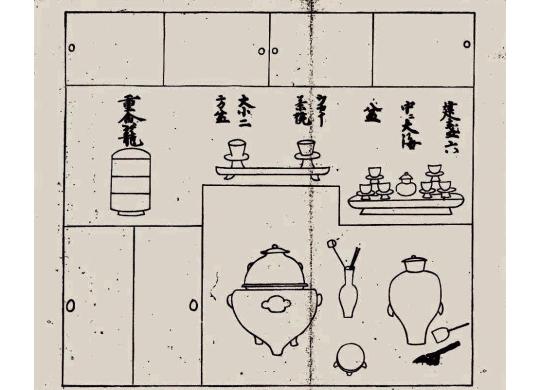
Sōwa was charged with “Japanizing” chanoyu, as the first step in the bakufu’s process of declaring that chanoyu (as a now-established purely, and authentically, Japanese traditional practice of great antiquity), of an appropriate level of formality appropriate to the rank of the government envoy they were entertaining (this is where the modern school’s ranked system of temae originated), must be included in the formal reception of every such official received (at least in an official capacity) by the daimyō and wealthy merchants.
The purpose of this rule was not only to effect the bakufu’s control, but also to force the daimyō and merchants to spend money on tea utensils (those that were to be used for the most formal services being ruinously expensive) -- money that would then no longer be available to those aspiring to rebellion against the Tokugawa government.
Nevertheless, it is important for the modern reader to understand, however, that only chanoyu included the service of koicha, and the dichotomy of koicha and usucha; and that is what identifies it as unique, and what contrasts chanoyu with all of the other uses of matcha that were practiced in Japan from the late Heian period until the fifteenth century.
²As has been mentioned before, because sunrise would be expected to occur during the naka-dachi, the artificial light will only be used during the shoza. And even then, since (in Jōō’s day) this kind of gathering would not begin until after dawn had broken*, the natural light coming in through the windows will be increasing, moment by moment, over the course of the shoza, so that the artificial illumination should be kept to the minimum, and focused near to the floor. ___________ *Again, this is a little different from the way things are usually done today. But since the time when the sei-ka-sui [井華水] (“the water that is the ‘flower of the well’”) could be drawn was limited to the 15 or 20 minutes when the dawn was actually breaking, the guests would have to be careful to time their arrival so that they would not interfere with this very important task. The idea was that the water had to be drawn and carried to the mizuya before any activity that might stir up dust could occur.
Since the intracity plots in places like Sakai and Kyōto were exceptionally small (and largely occupied by the residential building, business offices, and storehouse, with the roji being little more than a path that lead around to the back of the property where the chashitsu was erected between the well and the toilet facilities), the koshi-kake was always in close proximity to the well -- hence the desire, on the part of the guests, to postpone their arrival until after the host had drawn the water and carried it back to the preparation area. (And again, we must be careful not to impose our contemporary idea of roji design -- which originated in the Edo period -- on the facilities available to the chajin of Jōō’s and Rikyū’s time.)
³This change in wording was discussed at some length in the previous post. Akatsuki [曉] seems to have been substituted for asa [朝] by Hosokawa Sansai, since this is the kanji that is found in all of the versions that can ultimately trace their source back to his collection (which, along with his other treatises on chanoyu, was written down during the last decade of his life -- Sansai died during the winter of 1645-1646).
The specificity of this word reflects the way that the early-morning chakai had come to be staged during the first half-century of the Edo period, the period to which the modern interpretation of the dawn gathering -- the akatsuki-no-chaji [曉の茶事] -- traces its root.
==============================================
◎ If these translations are valuable to you, please consider donating to support this work. Donations from the readers are the only source of income for the translator.
To contribute, please use the following link:
https://PayPal.Me/chanoyutowa
3 notes
·
View notes
Text
Episode 16 (Ep.40): Festering Resentment / 第16話(第40話)『巣食う悪意(すくうあくい/Sukuu Akui)』
猫猫(マオマオ)「う~ん…、あった」
Maomao “Uuun…, atta.”
Maomao “Here it is.”
壬氏(ジンシ)「お前(まえ)、かんざしは着(つ)けないのか?じゃあ、それを着(つ)けてこい」
Jinshi “Omae, kanzashi’wa tsuke-nai-noka? Jaa, sore’o tsukete-koi.”
Jinshi “Don’t you wear a hair stick? Wear that, then.”
猫猫(約束(やくそく)だし、仕方(しかた)ない)
Maomao (Yakusoku-dashi, shikata-nai.)
Maomao (A promise is a promise, I guess.)
――――――――――――――――――――――――――――――
虞淵(グエン)(やぶ医者(いしゃ))「ほら見(み)てごらん、羅門(ルォメン)さん。この子(こ)は賢(かしこ)いから、小魚(こざかな)の頭(あたま)と尾(お)とはらわたは食(た)べないんだよ」
Guen (Yabu-Isha) “Hora mite-goran, Ruomen-san. Kono ko’wa kashikoi-kara, kozakana’no atama’to o’to hara-wata’wa tabe-nain-dayo.”
Guen (Quack Doctor) “Look, Luomen. This one is so smart, she won’t eat the head, tail, or guts of the fish.”
羅門「この苦(にが)みが好(す)きなんですけどねぇ」
Ruomen “Kono nigami’ga suki-nan-desu-kedo-nee.”
Luomen “Personally, I like the bitter taste.”
猫猫(食(た)べ物(もの)は無駄(むだ)にするなと教(おし)えられたが、猫(ねこ)の残(のこ)り物(もの)まで食べるとは…。一(いち)を聞(き)いて十(じゅう)を知(し)る。おやじはこの国(くに)の最高(さいこう)の医師(いし)だと思(おも)う。なのに花街(はなまち)で貧(まず)しく暮(く)らしているのは、おやじには欲(よく)というものがないからだ)
Maomao (Tabemono’wa muda-ni suruna-to oshie-rareta-ga, neko’no nokori-mono-made taberu-towa… Ichi’o kiite ju’o shiru. Oyaji’wa kono kuni’no saiko’no ishi-dato omou. Nanoni hana-machi’de mazushiku kurashite-iru-nowa, oyaji’niwa yoku-to-iu mono’ga nai-kara-da.)
Maomao (He did teach me not to waste food, but who would’ve thought he’d eat leftovers from a cat… Learn ten things from one tip. My dad is the best doctor in this country, I think. But still, he lives in poverty in the pleasure district. Why? Because he feels no greed whatsoever.)
虞淵(やぶ医者)「嬢(じょう)ちゃん、さっきから何(なに)を作(つく)ってるんだい?」
Guen (Yabu-Isha) “Jochan, sakki’kara nani’o tsukutterun-dai?”
Guen (Quack Doctor) “What are you making, little lady?”
猫猫「玉葉様(ギョクヨウさま)の灸(きゅう)に使(つか)う、もぐさです」
Maomao “Gyokuyo-sama’no kyu’ni tsukau, mogusa desu.”
Maomao “Mugwort, for Lady Gyokuyou’s moxibustion.”
羅門「猫猫。ちゃんと虞淵さんに断(ことわ)ってから使いなさい」
Ruomen “Maomao. Chanto Guen-san’ni kotowatte-kara tsukai-nasai.”
Luomen “Maomao, ask for Guen’s permission before using things.”
猫猫「う…、は~い。おやじは今日(きょう)は書(か)き物(もの)?」
Maomao “U…, haaai. Oyaji’wa kyo’wa kaki-mono?”
Maomao “Yes. Are you going to write all day today, Dad?”
羅門「ああ、特(とく)にお呼(よ)びがないからね」
Ruomen “Aa, toku-ni oyobi’ga nai-kara-ne.”
Luomen “Yes. Nobody seems to need my services today.”
猫猫(おやじが翡翠宮(ひすいきゅう)専属(せんぞく)ではなく医局(いきょく)勤(づと)めになったのは、恐(おそ)らく壬氏様(ジンシさま)の計(はか)らいだ���今(いま)、後宮(こうきゅう)には少(すく)なくとももう一人(ひとり)、帝(みかど)の御子(みこ)を宿(やど)している方(かた)がいる。梨花様(リファさま)だ。次(つぎ)の子(こ)は無事(ぶじ)に育(そだ)ってほしい。そのために、まずは無事に産(う)んでもらいたい。おやじが両方(りょうほう)診(み)てくれるなら、安心(あんしん)だな)
Maomao (Oyaji’ga Hisui-Kyu sen-zoku’dewa-naku ikyoku-zutome’ni natta-nowa, osoraku Jinshi-sama’no hakarai-da. Ima, kokyu’niwa sukunaku-tomo mo-hitori, mikado’no miko’o yadoshite-iru kata’ga iru. Rifa-sama-da. Tsugi’no ko’wa buji-ni sodatte-hoshii. Sono-tame-ni, mazuwa buji-ni unde-morai-tai. Oyaji’ga ryoho mite-kureru-nara, anshin-dana.)
Maomao (Dad was assigned to the doctor’s office, not directly to the Jade Pavilion. It was probably Master Jinshi’s plan. At least one more person is carrying the emperor’s child in the rear palace. Lady Lihua. I hope her next child grows up healthy. For that, she first has to give birth safely. If Dad can look after both of them, I’ll be relieved.)
虞淵(やぶ医者)「そういえば、水晶宮(すいしょうきゅう)に新(あたら)しい侍女(じじょ)たちが入(はい)ったみたいだね。ほら、前(まえ)に会(あ)った侍女頭(じじょがしら)が辞(や)めた後(あと)」
Guen (Yabu-Isha) “So-ieba, Suisho-Kyu’ni atarashii jijo-tachi’ga haitta-mitai-dane. Hora, mae-ni atta jijo-gashira’ga yameta-ato.”
Guen (Quack Doctor) “Oh, did you hear about how the Crystal Pavilion got a batch of new ladies-in-waiting? You know, after the last head lady-in-waiting left?”
猫猫「あぁ…」
Maomao “Aa…”
Maomao “Yeah…”
虞淵(やぶ医者)「年配(ねんぱい)の侍女(じじょ)が多(おお)くて、急(きゅう)に宮(みや)の雰囲気(ふんいき)が落(お)ち着(つ)いたってさ」
Guen (Yabu-Isha) “Nenpai’no jijo’ga ookute, kyu-ni miya’no fun’iki’ga ochi-tsuitatte-sa.”
Guen (Quack Doctor) “I heard many of them are older, so the atmosphere there got a lot calmer.”
羅門「経験豊富(けいけんほうふ)な侍女が増(ふ)えるのは、いいことです」
Ruomen “Keiken-hofu-na jijo’ga fueru-nowa ii-koto-desu.”
Luomen “It’s good to have many experienced ladies-in-waiting.”
猫猫(後宮(こうきゅう)には若(わか)い女官(にょかん)が多(おお)いが、年配(ねんぱい)の女官(にょかん)は極端(きょくたん)に少(すく)ない。後宮は帝(みかど)の子(こ)を産(う)み、育(そだ)てる場(ば)。なのに、それが機能(きのう)していない。今(いま)の帝(みかど)の子(こ)が何人(なんにん)いるかを考(かんが)えれば、改善(かいぜん)すべきだ。この問題点(もんだいてん)に、おやじならもう気付(きづ)いていると思(おも)うけど)
Maomao (Kokyu’niwa Wakai nyokan’ga ooi-ga, nenpai’no nyokan’wa kyokutan-ni sukunai. Kokyu’wa mikado’no ko’o umi, sodateru ba. Nanoni, sore’ga kino-shite-inai. Ima’no mikado’no ko’ga nan-nin iruka’o kangae-reba, kaizen-subeki-da. Kono mondai-ten’ni, oyaji-nara mo kizuite-iru-to omou-kedo.)
Maomao (Many of the workers in the rear palace are young. Elderly women are extremely rare. The rear palace is for birthing and raising the emperor’s children. It’s not functioning properly right now. Given how many children the emperor has right now, that needs to be improved. I’m sure my dad realizes this problem by now, but…)
羅門「うん、こんなものかな」
Ruomen “Un, konna mono kana.”
Luomen “Hmm. That should do.”
猫猫「おやじ、これは?」
Maomao “Oyaji, kore’wa?”
Maomao “What is this, Dad?”
羅門「今(いま)の後宮(こうきゅう)で気(き)になるところをまとめてみたんだ」
Ruomen “Ima’no kokyu’de kini-naru tokoro’o matomete-mitanda.”
Luomen “I wrote down the things I find concerning in the rear palace right now.”
虞淵(やぶ医者)「どれどれ…羅門さん、綺麗(きれい)な字(じ)を書(か)くねぇ」
Guen (Yabu-Isha) “Dore-dore… Ruomen-san, kirei-na ji’o kaku-nee.”
Guen (Quack Doctor) “Let’s see. Wow, Luomen, your handwriting is very pretty.”
猫猫(そこかよ)
Maomao (Soko-kayo.)
Maomao (That’s what you notice?)
虞淵(やぶ医者)「でも何(なん)か、子供(こども)っぽい文(ぶん)だねぇ。威厳(いげん)が足(た)りないんじゃないかい?」
Guen (Yabu-Isha) “Demo nanka, kodomoppoi bun-danee. Igen’ga tari-nainja nai-kai?”
Guen (Quack Doctor) “But the tone is kind of childish. Perhaps you need to sound more authoritative?”
羅門「いいんですよ。ここにはまだ簡単(かんたん)な文(ぶん)や文字(もじ)しか読(よ)めない者(もの)もいますから」
Ruomen “Iin-desu-yo. Koko’niwa mada kantan-na bun’ya moji-shika yome-nai mono’mo imasu-kara.”
Luomen “That’s fine. There are many here who can still only read simple characters and phrases.”
猫猫(なるほど…。これは侍女(じじょ)や下女(げじょ)に読(よ)ませたいのか)
Maomao (Naru-hodo… Kore’wa jijo’ya gejo’ni yomase-tai-noka.)
Maomao (I see. He wants servant girls and workers to read this.)
羅門「どうかな?見落(みお)としはないかね?」
Ruomen “Do-kana? Miotoshi’wa nai-kane?”
Luomen “What do you think? Did I miss anything?”
猫猫「足(た)りてると思(おも)うけど」
Maomao “Tariteru-to omou-kedo.”
Maomao “I think you’ve covered most of it, but…”
羅門「虞淵さん、ご実家(じっか)にこのくらいの大(おお)きさの紙(かみ)は置(お)いてありますか?」
Ruomen “Guen-san, go-jikka’ni kono-kurai’no ookisa’no kami’wa oite-ari-masu-ka?”
Luomen “Guen, does your family sell paper about this size?”
虞淵(やぶ医者)「そんな切(き)れ端(はし)、溶(と)かして新(あたら)しい紙(かみ)の材料(ざいりょう)にしてしまうねぇ」
Guen (Yabu-Isha) “Sonna kire-hashi, taokashite atarashii kami’no zairyo’ni shite-shimau-nee.”
Guen (Quack Doctor) “A scrap like that would get melted down to make more new paper.”
羅門「ではそれを安値(やすね)で譲(ゆず)っていただくことは可能(かのう)でしょうか?」
Ruomen “Dewa sore’o yasu-ne’de yuzutte-itadaku-koto’wa kano desho-ka?”
Luomen “In that case, would it be possible to get more at a low price?”
虞淵(やぶ医者)「うん、できると思(おも)うよ」
Guen (Yabu-Isha) “Un, dekiru-to omou-yo.”
Guen (Quack Doctor) “Yes, I think so.”
羅門「猫猫、最近(さいきん)、手習(てなら)い所(じょ)が作(つく)られたね?」
Ruomen “Maomao, saikin tenarai-jo’ga tsuku-rareta-ne?”
Luomen “Maomao, they built a school here recently, right?”
猫猫「うん」
Maomao “Un.”
Maomao “Yes.”
羅門「じゃあ、これを書(か)き取(と)り練習(れんしゅう)の手本(てほん)にできないか、聞(き)いてみてくれないかね?」
Ruomen “Jaa, kore’o kaki-tori-renshu’no tehon’ni deki-nai-ka, kiite-mite-kurenai-kane?”
Luomen “In that case, can you go and ask if they can use this as an example to practice writing with?”
猫猫「あ…、生徒(せいと)の手(て)を借(か)りて、張(は)り紙(がみ)を量産(りょうさん)するってことか。今日(きょう)あたり、��ょっと聞(き)いてみる」
Maomao “A… Seito’no te’o karite, hari-gami’o ryosan-surutte-koto-ka. Kyo-atari, chotto kiite-miru.”
Maomao “Ah. You want to get the students to help mass-produce the notice. I’ll go ask today.”
羅門「うん、頼(たの)むよ」
Ruomen “Un, tanomu-yo.”
Luomen “Thank you.”
猫猫(人(ひと)も物(もの)も無駄(むだ)にしない。商人(しょうにん)のような頭(あたま)の回(まわ)りようだ。どうしてその才覚(さいかく)を自分(じぶん)の生活(せいかつ)に生(い)かせないんだか…)
Maomao (Hito’mo mono’mo muda-ni shinai. Shonin’no-yona atama’no mawari-yo-da. Doshite sono saikaku’o jibun’no seikatsu’ni ikase-nain-daka…)
Maomao (He thinks like a merchant, not putting manpower or materials to waste. Now why can’t he use that intellect to improve his own life?)
猫猫「じゃ、もぐさもできたので、戻(もど)ります。翡翠宮用(ひすいきゅうよう)に、消毒用(しょうどくよう)のアルコール、もらっていきますね」
Maomao “Ja, mogusa’mo dekita-node, modori-masu. Hisui-Kyu-yo’ni, shodoku-yo’no arukōru, moratte-iki-masu-ne.”
Maomao “Well, my mugwort is ready, so I’ll go now. Oh, and I’m taking some disinfecting alcohol for the Jade Pavilion.”
虞淵(やぶ医者)「はいよ」
Guen (Yabu-Isha) “Hai-yo.”
Guen (Quack Doctor) “Sure.”
猫猫「あと、疲労回復(ひろうかいふく)に効くものを…」
Maomao “Ato, hiro-kaifuku’ni kiku mono’o…”
Maomao “Also, something for fatigue…”
猫猫(最近(さいきん)、玉葉様(ギョクヨウさま)が疲(つか)れやすいって言(い)ってたからな…)
Maomao (Saikin, Gyokuyo-sama’ga tsukare-yasuitte itteta-kara-na…)
Maomao (Lady Gyokuyou said she gets tired easily recently.)
猫猫「こら、破(やぶ)ける」
Maomao “Kora, yabukeru.”
Maomao “Stop, you’ll tear it.”
虞淵(やぶ医者)「どうした毛毛(マオマオ)、そんなに鳴(な)いて」
Guen (Yabu-Isha) “Do-shita Maomao, sonna-ni naite.”
Guen (Quack Doctor) “What’s wrong, Maomao? You’re making such a fuss.”
猫猫「これかな…。やらないから」
Maomao “Kore-kana… Yara-nai-kara.”
Maomao “Maybe it’s this. You can’t have it.”
猫猫(さて、どうしたもんか…。先に手習(てなら)い所(じょ)に行(い)ってみるか。壬氏様(ジンシさま)に話(はなし)を通(とお)すとなると、時間(じかん)がかかるだろうし…。ん…。一応(いちお��)、持(も)ち歩(ある)いてはいるけど、前(まえ)に着(つ)けてみたら…)
Maomao (Sate, do-shita-mon-ka… Saki-ni tenarai-jo’ni itte-miru-ka. Jinshi-sama’ni hanashi’o toosu-to-naruto, jikan’ga kakaru-daroshi… N… Ichio, mochi-aruitewa iru-kedo, mae-ni tsukete-mitara…)
Maomao (So, what to do next… Should I go to the school first? Going through Master Jinshi would probably take time. I’m carrying it with me, but the last time I put it on…)
桜花(インファ)「あ~!そのかんざし、園遊会(えんゆうかい)で壬氏様にもらったものじゃない!?」
Infa “Aaa! Sono kanzashi, en’yu-kai’de Jinshi-sama’ni moratta mono-ja nai!?”
Yinghua “Hey! Isn’t that the hair stick you got from Master Jinshi at the garden party?!”
貴園(グイエン)「急(きゅう)に着(つ)けて、どうしたの~?」
Guien “Kyu-ni tsukete, do-shita-nooo?”
Guiyuan “Why did you decide to wear it all of a sudden?!”
猫猫(後(あと)でいいや…)
Maomao (Ato’de ii-ya…)
Maomao (Maybe later.)
――――――――――――――――――――――――――――――
老宦官(ろうかんがん)「これは…羅門の字(じ)だね」
Ro-kangan “Kore’wa… Ruomen’no ji-dane.”
Old eunuch “This is Luomen’s handwriting.”
猫猫「よくお分(わ)かりで」
Maomao “Yoku owakari-de.”
Maomao “You can tell?”
老宦官「昔(むかし)、科挙(かきょ)の試験(しけん)の時(とき)、あやつの字(じ)を真似(まね)ると受かるなんて言われて、皆(みな)で真似(まね)したからねぇ。文官(ぶんかん)としての才(さい)もあったのに、道端(みちばた)の浮浪児(ふろうじ)が、病気(びょうき)でかわいそうだからと言(い)って、医官(いかん)になるんだから…」
Ro-kangan “Mukashi, kakyo’no shiken’no toki, ayatsu’no ji’o maneru-to ukaru-nante iwarete, mina’de mane-shita-kara-nee. Bunkan-to-shite’no sai’mo atta-noni, michi-bata’no furo-ji’ga, byoki-de kawaiso-dakara-to-itte, ikan’ni narun-dakara…”
Old eunuch “Back in the day, we all used to say copying his handwriting made it easier to pass the civil service exams, so we practiced it. He had the talent to become a government official, but instead, he became a doctor, because he felt sorry for the sick, homeless children.”
猫猫「実(じつ)は今(いま)、後宮(こうきゅう)に戻(もど)���てきておりまして」
Maomao “Jitsu’wa ima, kokyu’ni modotte-kite-ori-mashite.”
Maomao “He’s actually back in the rear palace right now.”
老宦官「ほう、それは初耳(はつみみ)だ。今日(きょう)は小蘭(シャオラン)はいないのかね?」
Ro-kangan “Ho, sore’wa hatsu-mimi-da. Kyo’wa Shaoran’wa inai-no-kane?”
Old eunuch “Oh, that’s news to me. Isn’t Xiaolan here today?”
猫猫「最近(さいきん)は、年季明(ねんきあ)けの心配(しんぱい)と、若(わか)い宦官(かんがん)の話(はなし)に夢中(むちゅう)で、それどころじゃないようです」
Maomao “Saikin’wa, nenki-ake’no shinpai-to, wakai kangan’no hanashi’ni muchu-de, sore-dokoro-ja nai-yo-desu.”
Maomao “She’s a bit preoccupied lately because of her term expiring, and because of that young eunuch.”
老宦官「若(わか)い宦官(かんがん)ねぇ…。刺激(しげき)が少(すく)ないとはいえ、騒(さわ)ぎ立(た)てるのもどうかと思(おも)うんだがね」
Ro-kangan “Wakai kangan-nee… Shigeki’ga sukunai-towa-ie, sawagi-tateru-nomo doka-to omoun-daga-ne.”
Old eunuch “A young eunuch, right… I know excitement is rare around here, but is that really worth all the fuss?”
猫猫「どういうことですか?」
Maomao “Do-iu-koto desu-ka?”
Maomao “What do you mean?”
老宦官「いや、南側(みなみがわ)に若(わか)い宦官(かんがん)を置(お)いておくと、女官(にょかん)たちの仕事(しごと)がおろそかになるからって、北側(きたがわ)に数人(すうにん)送(おく)られてきたんだよ。診療所(しんりょうじょ)の女官(にょかん)は、男手(おとこで)が増(ふ)えて助(たす)かっているようだけど」
Ro-kangan “Iya, minami-gawa’ni wakai kangan’o oite-oku-to, jokan-tachi’no shigoto’ga orosoka-ni naru-karatte, kita-gawa’ni su-nin oku-rarete-kitan-dayo. Shinryo-jo’no nyokan’wa, otoko-de’ga fuete tasukatte-iru-yo-dakedo.”
Old eunuch “Well, they said having the young eunuchs on the south side made the court ladies stop concentrating on work. So, they sent a few of the eunuchs to the north side. I heard the court ladies at the clinic appreciate the male help.”
猫猫(診療所(しんりょうじょ)か…。深緑(シェンリュ)様(さま)なら、若い宦官(かんがん)をこき使(つか)いそうだ)
Maomao (Shinryo-jo-ka… Shenryu-sama-nara, wakai kangan’o koki-tsukai-soda.)
Maomao (The clinic… I guess Lady Shenlü would have a lot of work for the young eunuchs.)
老宦官「それで、用(よう)と言(い)うのは?」
Ro-kangan “Sorede, yo-to iu-nowa?”
Old eunuch “So, what did you need today?”
猫猫「ああ、はい。この養父(ようふ)が書(か)いたものを手本(てほん)に、生徒(せいと)たちに書(か)き取(と)りの練習(れんしゅう)をしてもらえない��と…。紙(かみ)は用意(ようい)します」
Maomao “Aa, hai. Kono yofu’ga kaita-mono’o tehon-ni, seito-tachi’ni kaki-tori’no renshu’o shite-morae-naika-to… Kami’wa yoi-shimasu.”
Maomao “Oh, right. My adoptive father wanted you to use this text he wrote as an example for students to practice writing with. He will provide the paper.”
老宦官「ははぁ。これを書(か)き写(か)させて、あちこち張(は)ろうってことだね」
Ro-kangan “Hahaa. Kore’o kaki-utsu-sasete, achi-kochi harotte koto-dane.”
Old eunuch “Ha, ha. He wants to make copies to put them up everywhere.”
猫猫「ええ」
Maomao “Ee.”
Maomao “Yes.”
老宦官「昔(むかし)も、似(に)たようなことを書(か)いていたねぇ。あの時(とき)は、羅門一人(ひとり)でやっていたから、つい私(わたし)も手伝(てつだ)ってしまったよ。2人(ふたり)で、後宮中(こうきゅうじゅう)に張(は)る紙(かみ)をひたすら書(か)いて…。あやつも年(とし)を食(く)って、人(ひと)をうまく使(つか)う方法(ほうほう)を覚(おぼ)えたようだね」
Ro-kangan “Mukashi’mo, nita-yona koto’o kaite-ita-nee. Ano toki’wa, Ruomen-hitori’de yatte-ita-kara, tsui watashi’mo tetsudatte-shimatta-yo. Futari’de, kokyu-ju’ni haru kami’o hitasura kaite… Ayatsu’mo toshi’o kutte, hito’o umaku tsukau hoho’o oboeta-yo-dane.”
Old eunuch “He used to write similar things in the past. He made them all by himself back then, so I ended up helping. The two of us, writing and writing, to post these all over the rear palace… I guess, with age, he learned how to cleverly put other people to work.”
猫猫「以前(いぜん)にも、こうして文(ぶん)にして張(は)っていたのですか?」
Maomao “Izen’nimo, koshite bun’ni-shite hatte-itano-desu-ka?”
Maomao “So, you posted paper notices in the past, too?”
老宦官「ああ。羅門が医官(いかん)をしていた頃(ころ)だから、20年以上前(にじゅうねんいじょうまえ)だねぇ。後宮(こうきゅう)のあちこちに張(は)られていたよ。『鉛入(なまりい)りのおしろいは使(つか)わない』、『強(つよ)い香料(こうりょう)は控(ひか)える』、『後宮内(こうきゅうない)の植物(しょくぶつ)を勝手(かって)に採(と )らない』。うん、内容(ないよう)はそこまで変(か)わらないな」
Ro-kangan “Aa. Ruomen’ga ikan’o shite-ita-koro-dakara, niju-nen-ijo-mae-danee. Kokyu’no achi-kochi’ni hararete-ita-yo. ‘Namari-iri’no oshiroi’wa tsukawa-nai’, ‘Tsuyoi koryo’wa hikaeru’, ‘Kokyu-nai’no shokubutsu’o katteni tora-nai’. Un, naiyo’wa soko-made kawara-nai-na.”
Old eunuch “Yes, it was back when Luomen was a doctor here, so it was more than 20 years ago. It was all over the rear palace. ‘Don’t use whitening powder with lead in it, avoid strong scents, don’t pick plants in the rear palace without permission…’ Yes, the content is mostly the same.”
猫猫(これと同(おな)じものが…?何(なん)だ?この違和感(いわかん))
Maomao (Kore-to onaji-mono’ga…? Nan-da? Kono iwa-kan.)
Maomao (Same as this…? What is this uneasy feeling?)
猫猫「後(のち)ほど紙(かみ)を持(も)ってきます!」
Maomao “Nochi-hodo kami’o motte-kimasu!”
Maomao “I’ll bring paper later!”
老宦官「うん」
Ro-kangan “Un.”
Old eunuch “Yes.”
――――――――――――――――――――――――――――――
猫猫(おやじは、良(よ)かれと思(おも)って注意書(ちゅういが)きを張(は)ったはずだ。それは、逆(ぎゃく)に悪意(あくい)ある者(もの)に、害(がい)をなすものを教(おし)えることにもなる。後宮(こうきゅう)の人員(じんいん)は、ほとんどが2年(にねん)の年季(ねんき)で入(い)れ替(か)わる。妃(きさき)もまた、先帝(せんてい)の崩御(ほうぎょ)で入れ替わっている。あの当時(とうじ)の張(は)り紙(がみ)を知(し)っている者(もの)、それは…)
Maomao (Oyaji’wa, yokare-to omotte chui-gaki’o hatta-hazu-da. Sore’wa, gyaku-ni akui-aru-mono’ni, gai’o nasu-mono’o oshieru koto-nimo naru. Kokyu’no jin’in’wa, hotondo’ga ni-nen’no nenki’de ire-kawaru. Kisaki’mo-mata, sentei’no hogyo’de ire-kawatte-iru. Ano-toji’no hari-gami’o shitte-iru-mono, sore’wa…)
Maomao (Dad must have posted the warnings out of pure goodwill. But it helps those with evil intent learn about harmful substances. Most of the workforce at the rear palace is replaced every two years. When the late emperor passed away, the concubines were replaced, too. Who would know about the warnings posted the last time? It would be…)
猫猫「失礼(しつれい)します」
Maomao “Shitsu-rei-shimasu.”
Maomao “Excuse me.”
深緑「あら」
Shenryu “Ara.”
Shenlü “Oh.”
猫猫「んっ…」
Maomao “N…”
深緑「あなた翡翠宮(ひすいきゅう)の…」
Shenryu “Anata Hisui-Kyu’no…”
Shenlü “You’re from the Jade Pavilion.”
猫猫「深緑(シェンリュ)様(さま)」
Maomao “Shenryu-sama.”
Maomao “Lady Shenlü.”
深緑「体調(たいちょう)でも悪(わる)いの?」
Shenryu “Taicho’demo warui-no?”
Shenlü “Are you feeling unwell?”
猫猫「あっ、いえ…」
Maomao “A, ie…”
Maomao “Oh, no…”
猫猫(切(き)り出(だ)すべきだろうか?でも、どうやって…)
Maomao (Kiri-dasu-beki-daro-ka? Demo, do-yatte…)
Maomao (Should I bring it up? But how…)
猫猫「あっ。あの、これ、アルコールです。蒸留(じょうりゅう)した、濃(こ)いものなので、消毒(しょうどく)にいいかと」
Maomao “A. Ano, kore, arukōru desu. Joryu-shita, koi-mono-nanode, shodoku’ni ii-kato.”
Maomao “Oh. Um, this is alcohol. It’s distilled and very strong, so it should be a good disinfectant.”
深緑「いいのですか?いただいても」
Shenryu “Ii-no-desuka? Itadai-temo.”
Shenlü “Are you sure we can have this?”
猫猫「ええ。多(おお)めに作(つく)りましたので」
Maomao “Ee. Oome-ni tsukuri-mashita-node.”
Maomao “Yes, I made a lot.”
深緑「ありがとう。お茶(ちゃ)でも入(い)れるわ」
Shenryu “Arigato. Ocha’demo ireru-wa.”
Shenlü “Thank you. Let me make some tea.”
猫猫「ところで、ここの診療所(しんりょうじょ)にいる方(かた)は、皆(みな)、優秀(ゆうしゅう)なのですね」
Maomao “Tokorode, koko’no shinryo-jo’ni iru kata’wa, mina, yushu-nano-desu-ne.”
Maomao “By the way, the people at this clinic seem very skilled.”
深緑「どういう意味(いみ)?」
Shenryu “Do-iu imi?”
Shenlü “What do you mean?”
猫猫「後宮(こうきゅう)の女官(にょかん)は大体(だいたい)2年(にねん)が年季(ねんき)ですが、皆様(みなさま)長(なが)くいらっしゃるようなので」
Maomao “Kokyu’no nyokan’wa dai-tai ni-nen’ga nenki-desu-ga, mina-sama nagaku irassharu-yo-nanode.”
Maomao “The term length of rear palace workers is usually two years, but the workers here seem to have been here for longer.”
深緑「年増(としま)ばかりだもの」
Shenryu “Toshima-bakari-da-mono.”
Shenlü “We’re all just old.”
猫猫(10代(じゅうだい)、20代(にじゅうだい)で入(はい)ったとして、20年以上(にじゅうねんいじょう)。何(なに)か後宮(こうきゅう)を出(で)られない理由(りゆう)があるとしたら…)
Maomao (Ju-dai, niju-dai’de haitta-to-shite, niju-nen-ijo. Nanika kokyu’o derare-nai riyu’ga aru-to-shitara…)
Maomao (Assuming they had joined in their teens or twenties… There must be a reason why they’ve stayed at the rear palace for over twenty years.)
深緑「私(わたし)たちだって若(わか)かったわよ。私は10歳(じゅっさい)で後宮(こうきゅう)に入った。他(ほか)の女官(にょかん)たちも、それくらいの歳(とし)で入(い)れられた人(ひと)ばかり」
Shenryu “Watashi-tachi-datte waka-katta-wayo. Watashi’wa jussai’de kokyu’ni haitta. Hoka’no nyokan-tachi’mo, sore-kurai’no toshi’de ire-rareta hito-bakari.”
Shenlü “We used to be young. I joined the rear palace at ten years old. The other court ladies joined at a similar age.”
猫猫(今(いま)の後宮(こうきゅう)では、そこまで若(わか)い娘(むすめ)を女官(にょかん)にすることはない。だが、先帝(せんてい)の時代(じだい)は…)
Maomao (Ima’no kokyu’dewa, soko-made wakai musume’o nyokan’ni suru-koto’wa nai. Daga, sentei’no jidai’wa…)
Maomao (In the current rear palace, they don’t hire girls at such a young age. But, back in the late emperor’s era…)
年嵩(としかさ)の女官(にょかん)「先帝(せんてい)は、年端(としは)もいかぬ少女(しょうじょ)を選(えら)んではその花(はな)を散(ち)らし、手折(たお)られた少女(しょうじょ)たちは外(そと)に出(で)ることを許(ゆる)されぬまま…」
Toshi-kasa’no nyokan “Sentei’wa, toshiha’mo ikanu shojo’o erandewa sono hana’o chirashi, tao-rareta shojo-tachi’wa soto’ni deru-koto’o yuru-sarenu-mama…”
Old court lady “The late emperor chose the youngest girls, deflowering them one after the other. The girls spent their days in the rear palace, barred from ever leaving.”
猫猫(皇帝(こうてい)のお手付(てつ)きとなれば、ただの女官(にょかん)でも後宮(こうきゅう)を出(で)ることはできない)
Maomao (Kotei’no ote-tsuki-to nareba, tada’no nyokan’demo kokyu’o deru-koto’wa deki-nai.)
Maomao (Once the emperor lays his hands on you, you can’t leave the rear palace, even if you’re just a court lady.)
深緑「私(わたし)たちは誰(だれ)も迎(むか)えに来(き)てくれないから。今(いま)も…これからも…ずっと…」
Shenryu “Watashi-tachi’wa dare’mo mukae-ni kite-kure-nai-kara. Ima’mo…kore-kara’mo…zutto…”
Shenlü “There’s nobody out there waiting to welcome us back. Not before, not ever.”
猫猫(あぁ…そうか…。後宮(こうきゅう)に、帝(みかど)に、そして帝(みかど)から寵(ちょう)を得(え)る妃(きさき)たちに、巣食(すく)っていた悪意(あくい)は、ここにあった。深緑(シェンリュ)は以前(いぜん)、水晶宮(すいしょうきゅう)で病(やまい)に倒(たお)れた下女(げじょ)を心配(しんぱい)し、診(み)るように頼(たの)んできた。あの時(とき)は、よく気(き)の付(つ)く女官(にょかん)だと思(おも)った。だが…)
Maomao (Aa…soka… Kokyu’ni, mikado’ni, soshite mikado’kara cho’o eru kisaki-tachi’ni, sukutte-ita akui’wa, koko’ni atta. Shenryu’wa izen, Suisho-Kyu’de yamai’ni taoreta gejo’o shinpai-shi, miru-yoni tanonde-kita. Ano-toki’wa, yoku ki’no-tsuku nyokan-dato omotta. Daga…)
Maomao (I see now. The rear palace. The emperor. And the concubines who receive the emperor’s love. This is where the resentment toward them is festering. Before, Shenlü was worried about the servant who fell ill at the Crystal Pavilion, and asked me to check up on her. I just thought she was a considerate and observant court lady. But…)
猫猫(水晶宮(すいしょうきゅう)の侍女頭(じじょがしら)である杏(シン)に堕胎剤(だたいざい)の作(つく)り方(かた)を教(おし)えたのは、深緑(シェンリュ)ではないだろうか?直接(ちょくせつ)ではなく、あの病(やまい)に伏(ふ)せていた下女(げじょ)を使(つか)ったとしたら…)
Maomao (Suisho-Kyu’no jijo-gashira’de-aru Shin’ni datai-zai’no tsukuri-kata’o oshieta-nowa, Shenryu’dewa nai-daro-ka? Choku-setsu’dewa-naku, ano yamai’ni fusete-ita gejo’o tsukatta-to-shitara…)
Maomao (Perhaps it’s Shenlü who taught Shin, the head lady-in-waiting at the Crystal Pavilion, how to make abortifacients. What if she delivered the message indirectly, through that sick servant girl…)
――――――――――――――――――――――――――――――
思思「咳(せき)が止(と)まらなくて…」
Su-su? “Seki’ga tomara-nakute…”
Si-si? “The coughing won’t stop.”
深緑「診(み)せてごらん」
Shenryu “Misete-goran.”
Shenlü “Let me see.”
思思「あの…、うつる病(やまい)でしょうか?」
Su-su? “Ano…, utsuru yamai desho-ka?”
Si-si? “Um, is it contagious?”
深緑「何(なに)か気(き)になることでも?」
Shenryu “Nanika ki’ni-naru-koto’demo?”
Shenlü “Is something wrong?”
思思「梨花様(リファさま)にうつしたくないんです。もしかしたら、ご懐妊(かいにん)されてるかもしれなくて」
Su-su? “Rifa-sama’ni utsushi-taku-nain-desu. Moshika-shitara, go-kainin-sareteru-kamo shire-nakute.”
Si-si? “I don’t want Lady Lihua to get it. There’s a possibility that she’s pregnant.”
深緑「へえ…。これを、侍女頭(じじょがしら)の杏様(シンさま)に渡(わた)して」
Shenryu “Hee… Kore’o, jijo-gashira’no Shin-sama’ni watashite.”
Shenlü “I see. Give this to Lady Shin, the head lady-in-waiting.”
思思「何(なん)ですか?」
Su-su? “Nan-desu-ka?”
Si-si? “What is it?”
深緑「妊婦(にんぷ)に害(がい)があるものだ。合(あ)わせると堕胎剤(だたいざい)の材料(ざいりょう)に��るものもある。きっと梨花様のためになるよ」
Shenryu “Ninpu’ni gai’ga aru-mono-da. Awaseruto datai-zai’no zairyo’ni naru mono’mo aru. Kitto Rifa-sama’no tame-ni naru-yo.”
Shenlü “Things that are harmful to pregnant women. Some can even induce abortions if combined. This information will be useful for Lady Lihua.”
――――――――――――――――――――――――――――――
猫猫(避(さ)けるべきものは、悪意(あくい)ある者(もの)に、何(なに)が毒(どく)なのかを教(おし)えることにもなる。折(おり)よくキャラバンが来(き)て、その材料(ざいりょう)になるものが売(う)られていれば、手(て)にしない訳(わけ)がない…。なぜ売(う)っていたのか。診療所(しんりょうじょ)の女官(にょかん)たちが、『この香(こう)が欲(ほ)しい』と商人(しょうにん)に吹(ふ)き込(こ)んだのかもしれない。これまでのこと全(すべ)てに関(かか)わっていたかは分(わ)からない。殺意(さつい)とまでいかない悪意(あくい)が、少(すこ)しずつ後宮内(こうきゅうない)を蝕(むしば)み、巣食(すく)っていたのだろう)
Maomao (Sakeru-beki-mono’wa, akui-aru-mono’ni, nani’ga doku-nanoka’o oshieru-koto’nimo naru. Ori-yoku kyaraban’ga kite, sono zairyo’ni naru-mono’ga urarete-ireba, te’ni shinai wake’ga nai… Naze utte-ita-noka. Shinryo-jo’no nyokan-tachi’ga, ‘Kono ko’ga hoshii’to shonin’ni fuki-konda-no-kamo shire-nai. Kore-made’no koto-subete’ni kakawatte-itaka’wa wakara-nai. Satsui-to-made ika-nai akui’ga, sukoshi-zutsu kokyu-nai’o mushibami, sukutte-itano-daro.)
Maomao (Sharing information on things to avoid can also lead to those with bad intentions learning about what is poisonous. If a caravan arrived at the right time to provide those things, of course they would go for it. Why did they sell it? Perhaps the court ladies at the clinic told the merchants which scents they wanted. I don’t know if she was involved in all of the incidents so far. Even if it never became full-on murderous intent, resentment must have festered gradually, over a long time, within the rear palace.)
猫猫(問(と)い詰(つ)めるべきか…)
Maomao (Toi-tsumeru-beki-ka…)
Maomao (Should I question her…?)
深緑「どうしたんです?」
Shenryu “Do-shitan-desu?”
Shenlü “Is something wrong?”
猫猫「何(なん)でもありません」
Maomao “Nan’demo ari-masen.”
Maomao “It’s nothing.”
深緑「そう。ならいいですけど」
Shenryu “So. Nara ii-desu-kedo.”
Shenlü “I see. Alright, then.”
猫猫(いや、やめよう。証拠(しょうこ)も���言(しょうげん)もないし、曖昧(あいまい)なことは言(い)いたくない。ここは病(やまい)にかかった女官(にょかん)たちが頼(たよ)れる唯一(ゆいいつ)の場所(ばしょ)だ。なくなるのは避(さ)けたい)
Maomao (Iya, yameyo. Shoko’mo shogen’mo nai-shi, aimai-na koto’wa iitaku-nai. Koko’wa yamai’ni kakatta nyokan-tachi’ga tayoreru yui’itsu-no basho-da. Naku-naru-nowa sake-tai.)
Maomao (No, I shouldn’t. There’s no proof, not even a testimony. I don’t want to make vague accusations. This is the only place where a sick worker can get reliable treatment. I don’t want this place to go away.)
猫猫(私(わたし)にできるのは、診療所(しんりょうじょ)に巣食(すく)う悪意(あくい)が、他(ほか)に及(およ)ぶ前(まえ)に摘(つ)み取(と)るくらいか…)
Maomao (Watashi’ni dekiru-nowa, shinryo-jo’ni sukuu akui’ga, hoka’ni oyobu-mae-ni tsumi-toru-kurai-ka…)
Maomao (I guess the most I can do is to nip the bud of resentment festering in the clinic before it spreads elsewhere.)
深緑「…あの?」
Shenryu “…Ano?”
Shenlü “Um…”
猫猫「あ…、すみません。お邪魔(じゃま)しました。ん?」
Maomao “A…, sumi-masen. Ojama shima-shita. N?”
Maomao “I’m sorry to take up your time.”
深緑「もし、気(き)になる本(ほん)があれば、持(も)って行(い)っていいわよ。ただ、ちゃんと返(かえ)してね」
Shenryu “Moshi, ki’ni-naru hon’ga areba, motte-itte ii-wayo. Tada, chanto kaeshite-ne.”
Shenlü “If you want to read any of the books here, you can take them. Just make sure to bring them back.”
猫猫「たくさんありますね」
Maomao “Takusan ari-masu-ne.”
Maomao “There’s a lot of them.”
深緑「その本棚(ほんだな)、たまに本(ほん)が増(ふ)えてるのよね」
Shenryu “Sono hon-dana, tama-ni hon’ga fueteru-no-yone.”
Shenlü “Sometimes people add books to that shelf.”
猫猫「あっ」
Maomao “A.”
深緑「返(かえ)してくれるだけでいいのに」
Shenryu “Kaeshite-kureru-dake’de ii-noni.”
Shenlü “They just have to return them.”
猫猫「随分(ずいぶん)立派(りっぱ)な虫(むし)の図説(ずせつ)ですね」
Maomao “Zuibun rippa-na mushi’no zu-setsu desu-ne.”
Maomao “This is a very impressive book on insects.”
深緑「あぁ、それもいつの間(ま)にか置(お)いてあったのよね。ひと月前(つきまえ)くらいかしら…」
Shenryu “Aa, sore’mo itsu’no-ma’nika oite-atta-no-yone. Hito-tsuki-mae-kurai kashira…”
Shenlü “Yes, that was one that was added without me noticing. About a month ago, I think.”
猫猫「これは……」
Maomao “Kore’wa……”
Maomao “This is…”
猫猫(ひと月(つき)と言う��、特使(とくし)を迎(むか)えての宴(うたげ)があった後(あと)だ。そういえば…)
Maomao (Hito-tsuki-to-iuto, tokushi’o mukaete’no utage’ga atta ato-da. So-ieba...)
Maomao (A month ago, which was around when the party with the special envoys took place. Come to think of it…)
子翠(シスイ)「ここほんとすごいよね!図鑑(ずかん)でしか見(み)たことない虫がいっぱい!」
Shisui “Koko honto sugoi-yone! Zukan’de-shika mita-koto-nai mushi’ga ippai!”
Shisui “This place is really great! There’s so many insects here I’ve only ever seen in books!”
猫猫(この図説(ずせつ)…子翠(シスイ)が持(も)ってきたのか?でも、こんな貴重(きちょう)な本(ほん)、下女(げじょ)の身(み)で持(も)てるだろうか…。子翠が虫(むし)の絵(え)を描(か)いていた時(とき)、紙(かみ)の帳面(ちょうめん)を使(つか)っていた。それに字(じ)も読(よ)める。何(なん)で下女(げじょ)をやってるんだ…?)
Maomao (Kono zu-setsu… Shisui’ga motte-kita-noka? Demo, konna kicho-na hon, gejo’no mi’de moteru-daro-ka… Shisui’ga mushi’no e’o kaite-ita-toki, kami’no chomen’o tsukatte-ita. Soreni ji’mo yomeru. Nande gejo’o yatterunda…?)
Maomao (This book… Did Shisui bring it? But how could a servant girl own such an expensive book? When Shisui was drawing pictures of insects, she used a notebook made of paper. She can read and write, too. Why is she a servant girl?)
翠苓「深緑、そいつには気(き)を付(つ)けた方(ほう)がいい」
Suirei “Shenryu, soitsu’niwa ki’o tsuketa-hoga ii.”
Suirei “Shenlü, you need to be careful with that one.”
深緑「あっ」
Shenryu “A.”
猫猫「ん?」(男(おとこ)にしては高(たか)い声(こえ)。女(おんな)にしては低(ひく)い声(こえ)。男(おとこ)にしては背(せ)が低(ひく)く、女(おんな)にしては背(せ)が高(たか)い。女官(にょかん)たちが黄色(きいろ)い声(こえ)を上(あ)げるのにふさわしい美貌(びぼう)の持(も)ち主(ぬし)…)
Maomao “N?” (Otoko’ni-shitewa takai koe. Onna’ni-shitewa hikui koe. Otoko’ni-shitewa se’ga hikuku, onna’ni-shitewa se’ga takai. Nyokan-tachi’ga ki’iroi koe’o ageru-noni fusawashii bibo’no mochi-nushi…)
Maomao (A voice uncharacteristically high for a man, but low for a woman. Shorter than an average man, but taller than an average woman. Someone beautiful, who attracts the attention of the court ladies…)
猫猫「ん…」(翠苓(スイレイ)……)
Maomao “N…” (Suirei……)
Maomao (Suirei…)
――――――――――――――――――――――――――――――
翠苓「深緑。そいつはお前(まえ)が何(なに)をしたか、さっきの会話(かいわ)で察(さっ)しているぞ」
Suirei “Shenryu. Soitsu’wa omae’ga nani’o shita-ka, sakki’no kaiwa’de sasshite-iru-zo.”
Suirei “Shenlü, she figured out what you did from your conversation earlier.”
深緑「はっ…」
Shenryu “Ha…”
翠苓「相変(あいか)わらず勘(かん)が働(はたら)くな。おかげで私(わたし)は死体(したい)になり損(そこ)ねた」
Suirei “Ai-kawarazu kan’ga hataraku-na. Okage’de watashi’wa shitai’ni nari-soko-neta.”
Suirei “You’re a smart one, as always. Like the time you prevented me from becoming a corpse.”
猫猫(叫(さけ)ぶか…それとも、アルコールのとっくりを投(な)げ付(つ)けた隙(すき)に逃(に)げるか…)
Maomao (Sakebu-ka… Sore-tomo, arukōru’no tokkuri’o nage-tsuketa-suki-ni nigeru-ka…)
Maomao (Should I scream? Or should I throw the bottle of alcohol and run?)
翠苓「余計(よけい)なことはしない方(ほう)がいい。動(うご)けば刺(さ)す」
Suirei “Yokei-na koto’wa shinai-hoga ii. Ugokeba sasu.”
Suirei “Don’t try anything. I’ll stab you if you move.”
猫猫「ここで私(わたし)を始末(しまつ)したところで、すぐ見(み)つかりますよ」
Maomao “Koko’de watashi’o shimatsu-shita-tokoro-de, sugu mitsukari-masu-yo.”
Maomao “If you killed me here, they’d find you right away.”
翠苓「できれば穏便(おんびん)に済(す)ませたい」
Suirei “Dekireba onbin-ni sumase-tai.”
Suirei “I want to end this peacefully, if possible.”
猫猫「あ…、蘇(よみがえ)りの薬(くすり)の後遺症(こういしょう)ですか?中祀(ちゅうし)で暗殺未遂(あんさつみすい)の後(あと)、あなたは毒(どく)をあおって死(し)んだ…ように見(み)せかけた。薬(くすり)を使(つか)って、しばらく仮死(かし)状態(じょうたい)になった影響(えいきょう)が、残(のこ)ってしまったんですね」
Maomao “A…, yomi-gaeri’no kusuri’no koi-sho desu-ka? Chushi’de ansatsu-misui’no-ato, anata’wa doku’o aotte shinda…yoni mise-kaketa. Kusuri’o tsukatte, shibaraku kashi-jotai-ni natta eikyo’ga, nokotte-shimattan-desu-ne.”
Maomao “Is that an aftereffect of the resurrection medicine? After the attempted assassination at the ceremony, you pretended to drink poison and die. Being in that near-death state for a while must have taken a toll on you.”
翠苓「それがどうした?こちらの目的(もくてき)を言(い)おうか」
Suirei “Sore’ga do-shita? Kochira’no mokuteki’o io-ka.”
Suirei “So what? Do you want to know what my goal is?”
猫猫「聞(き)くと思(おも)いますか」
Maomao “Kiku-to omoi-masu-ka.”
Maomao “You think I’ll listen?”
翠苓「聞いてもらう!」
Suirei “Kiite-morau!”
Suirei “You will!”
子翠「うっ…」
Shisui “U…”
猫猫「子翠!!」(やっぱり…さっきの図説(ずせつ)の持(も)ち主(ぬし)は子翠…)
Maomao “Shisui!!” (Yappari… Sakki’no zu-setsu’no mochi-nushi’wa Shisui…)
Maomao “Shisui!” (I knew it. That book was Shisui’s.)
子翠「ごめん、猫猫…」
Shisui “Gomen, Maomao…”
Shisui “Sorry, Maomao…”
翠苓「この娘(むすめ)がどうなってもいいのか?」
Suirei “Kono musume’ga do-nattemo ii-noka?”
Suirei “Do you care if this girl lives or dies?”
猫猫「あっ…何(なに)をすれば…」
Maomao “A… Nani’o sureba…”
Maomao “What do you want?”
翠苓「後宮(こうきゅう)を一緒(いっしょ)に出(で)てもらいたい」
Suirei “Kokyu’o issho-ni dete-morai-tai.”
Suirei “I want you to come with me, out of the rear palace.”
猫猫「後宮を出る…?そんなこと…」
Maomao “Kokyu’o deru…? Sonna koto…”
Maomao “Leave the rear palace? That’s…”
翠苓「できる。それに、お前(まえ)は絶対(ぜったい)、私(わたし)についてくる。…蘇(よみがえ)りの薬(くすり)。作(つく)り方(かた)を知(し)りたくないか?」
Suirei “Dekiru. Soreni, omae’wa zettai, watashi’ni tsuite-kuru. …Yomi-gaeri’no kusuri. Tsukuri-kata’o shiri-taku-nai-ka?”
Suirei “Possible. And I know you’ll follow me. Don’t you want to know how to make the resurrection medicine?”
猫猫(何(なん)てこと…言(い)いやがる…。やはり翠苓は侮(あなど)れない…)
Maomao (Nante-koto…ii-yagaru… Yahari Suirei’wa anadore-nai…)
Maomao (Unbelievable. She really must not be underestimated.)
――――――――――――――――――――――――――――――
語(かた)り「宮中(きゅうちゅう)には、東西(とうざい)に2匹(にひき)の獣(けもの)がいる。東(ひがし)に軍部(ぐんぶ)があることから、武官(ぶかん)に1匹(いっぴき)。西(にし)の代名詞(だいめいし)である文官(ぶんかん)に、もう1匹。つまり大尉(たいい)。軍部(ぐんぶ)の高官(こうかん)である羅漢(ラカン)が東(ひがし)の狐(きつね)。先帝(せんてい)の代(だい)からの重鎮(じゅうちん)であり、子北州(しほくしゅう)を治(おさ)める子昌(シショウ)が西(にし)の狸(たぬき)である」
Katari “Kyuchu’niwa, tozai-ni ni-hiki’no kemono’ga iru. Higashi-ni gunbu’ga aru-koto-kara, bukan’ni ippiki. Nishi-no daimeishi’de-aru bunkan-ni mo ippiki. Tsumari taii. Gunbu’no kokan’de-aru Rakan’ga higashi-no kitsune. Sentei’no dai’kara-no juchin’de-ari, Shihoku-shu’o osameru Shisho’ga nishi-no tanuki’de aru.”
Narration “There are two beasts in the palace, in the east and west. In the military headquarters to the east, a beast. To the west side, represented by bureaucracy, another. In other words, the grand commandant… Lakan, a high-ranking official, the fox in the east. And the political heavyweight from the late emperor’s era, the ruler of Shihoku-shu, Shishou, the tanuki of the west.”
馬閃(バセン)「何(なん)のご用(よう)でしょう?」
Basen “Nan’no goyo-desho?”
Basen “How may we be of service?”
羅漢「いや、何(なに)…。皇(おう)弟(てい)がひと月(つき)ぶりに、朝議(ちょうぎ)に参加(さんか)されておりますから、この後(あと)、茶(ちゃ)でもどうかと思(おも)いまして。せっかくの機会(きかい)ですから、子昌殿(シショウどの)もご一緒(いっしょ)にいかがかと」
Rakan “Iya, nani… Otei’ga hito-tsuki-buri’ni, chogi’ni sanka-sarete-orimasu-kara, kono-ato, cha’demo doka-to omoi-mashite. Sekkaku’no kikai-desu-kara, Shisho-dono’mo goissho-ni ikaga-kato.”
Lakan “Oh, it’s just that the imperial younger brother has joined the court council for the first time in a month. I was hoping to have some tea afterward. I also thought perhaps this would be a good opportunity to invite Master Shishou.”
子昌「ハハ…私(わたし)もですか。特(とく)に面白(おもしろ)い茶飲(ちゃの)み話(ばなし)はありませんぞ」
Shisho “Haha… Watashi-mo-desu-ka. Toku-ni omoshiroi cha-nomi-banashi’wa ari-masen-zo.”
Shishou “Oh, me too? I’m afraid I don’t have any interesting stories to tell.”
馬閃「付(つ)き合(あ)う、と言(い)っておられます」
Basen “Tsuki-au, to itte-orare-masu.”
Basen “He will join you.”
羅漢「では、中庭(なかにわ)にでも参(まい)りましょうか」
Rakan “Dewa, naka-niwa’ni-demo mairi-masho-ka.”
Lakan “In that case, let’s go to the center courtyard.”
――――――――――――――――――――――――――――――
羅漢「すっかり秋(あき)めいて参(まい)りましたなぁ。銀杯(ぎんはい)を用意(ようい)しました。毒見(どくみ)の���要(ひつよう)はございませんぞ」
Rakan “Sukkari aki-meite-mairi-mashita-naa. Gin-pai’o yoi-shima-shita. Dokumi’no hitsuyo’wa gozai-masen-zo.”
Lakan “Autumn is quite visibly here. I brought silver cups. You won’t need a taster.”
馬閃「美味(びみ)だと言(い)っておられます」
Basen “Bimi-dato itte-orare-masu.”
Basen “He says it is delicious.”
羅漢「フフフ…」
Rakan “Fufufu…”
子昌「羅漢(ラカン)殿(どの)。何(なに)か話(はなし)があるのでは?」
Shisho “Rakan-dono. Nanika hanashi’ga aru-no-dewa?”
Shishou “Master Lakan, I thought you had something to discuss.”
羅漢「先日(せんじつ)、子北洲(しほくしゅう)で皇弟(おうてい)の暗殺未遂(あんさつみすい)がありましたでしょう?その調査(ちょうさ)で面白(おもしろ)いものが手(て)に入(はい)りましてな…」
Rakan “Sen-jitsu, Shihoku-shu’de otei’no ansatsu-misui’ga ari-mashita-desho? Sono chosa’de omoshiroi mono’ga te’ni hairi-mashite-na…”
Lakan “Remember the attempted assassination of the imperial younger brother the other day in Shihoku-shu? Our investigation turned up something interesting.”
馬閃「これは…飛発(フェイファ)の設計図(せっけいず)!?」
Basen “Kore’wa… feifa’no sekkei-zu!?”
Basen “Is this… schematics for a feifa?!”
羅漢「これが何(なに)かご存知(ぞんじ)ですかな?子昌殿」
Rakan “Kore’ga nani-ka gozonji desu-kana? Shisho-dono.”
Lakan “Do you know what this is, Master Shishou?”
子昌「ほう…何(なん)ですかな?これは」
Shisho “Ho… Nan-desu-kana? Kore’wa.”
Shishou “What is this?”
羅漢「犯人(はんにん)たちが所持(しょじ)していた凶器(きょうき)です。そうですよね?」
Rakan “Han’nin-tachi’ga shoji-shite-ita kyoki desu. So-desu-yone?”
Lakan “This is the weapon that the assassins were carrying. Correct?”
馬閃「うっ…失礼(しつれい)。続けてください」
Basen “U… shitsu-rei. Tsuzukete-kudasai.”
Basen “Excuse me, please continue.”
羅漢「これは、解体(かいたい)して図(ず)に起(お)こしたものですが、西方(さいほう)の最新式(さいしんしき)のようでしてね。ここ。撃鉄(げきてつ)の先(さき)に火縄(ひなわ)ではなく、火打石(ひうちいし)が付(つ)いていまして、不発(ふはつ)も少(すく)なく、構造(こうぞう)も案外(あんがい)簡単(かんたん)だ」
Rakan “Kore’wa, kaitai-shite zu’ni okoshita mono-desu-ga, saiho’no saishin-shiki’no yo-deshite-ne. Koko. Geki-tetsu’no saki-ni hi-nawa’dewa-naku, hiuchi-ishi’ga tsuite-imashite, fuhatsu’mo sukunaku, kozo’mo angai kantan-da.”
Lakan “We took it apart and drew up the schematics. It seems to be the latest model developed in the west. Here, at the tip of the hammer, instead of a fuse, there’s a piece of flint. It misfires less frequently, and the design is simpler than expected.”
子昌「それは大層(たいそう)なものですな」
Shisho “Sore’wa taiso-na mono desu-na.”
Shishou “That’s quite impressive.”
羅漢「ええ。大量(たいりょう)に作(つく)ることができれば、戦(いくさ)がガラリと変(か)わるでしょうな。より密集(みっしゅう)した陣形(じんけい)も取れるし、移動(いどう)もしやすい。それを…皇(おう)弟(てい)の命(いのち)を狙(ねら)うような不届(ふとど)き者(もの)が持(も)つとは。あやつらは、どうやってこれを手(て)に入(い)れたんですかねぇ…」
Rakan “Ee. Tairyo-ni tsukuru-koto’ga dekireba, ikusa’ga garari-to kawaru-desho-na. Yori misshu-shita jinkei’mo torero-shi, ido’mo shi-yasui. Sore’o…otei’no inochi’o nerau-yona futodoki-mono’ga motsu-towa. Ayatsu-ra’wa, do-yatte kore’o te’ni-iretan-desu-ka-nee…”
Lakan “Yes. If it could be mass-produced, it would change the shape of warfare. It would allow for more tightly-packed formations, and make travel easier. Such an item being carried by scoundrels who seek to assassinate the imperial younger brother… I wonder how they got their hands on this.”
子昌「さあ……。それを調(しら)べるのも、そちらの役目(やくめ)でしょう」
Shisho “Saa…… Sore’o shiraberu-nomo, sochira’no yakume-desho.”
Shishou “Who knows? That’s for you to find out, isn’t it?”
羅漢「ええ、そうなんですが、いやぁ、困(こま)ったものでして…。担当部署(たんとうぶしょ)の者(もの)が加減(かげん)を間違(まちが)えたようで、何(なに)もしゃべれなくなってしまいました」
Rakan “Ee, so-nan-desu-ga, iyaa, komatta-mono-deshite… Tanto-busho’no mono’ga kagen’o machigaeta-yode, nani’mo shabere-naku natte-shimai-mashita.”
Lakan “True, but we’re in a bit of a bind. The interrogator in charge got a little overzealous, and the suspect can no longer speak.”
馬閃(皇族(こうぞく)の暗殺(あんさつ)を企(くわだ)てた者(もの)に容赦(ようしゃ)ないとは言え、拷問(ごうもん)の加減(かげん)を間違(まちが)えたとは、多大(ただい)な損失(そんしつ)だ…)
Basen (Kozoku’no ansatsu’o kuwadateta mono’ni yosha-nai-towa-ie, gomon’no kagen’o machigaeta-towa, tadai-na sonshitsu-da…)
Basen (An attempted assassin of the imperial younger brother should be shown no mercy, I wonder how they got their hands on this, but still, botching the interrogation process is a huge loss.)
羅漢「それで…何(なに)か、それらしい話(はなし)を聞(き)いたことはありませんかな?子昌殿」
Rakan “Sorede… Nani-ka, sore-rashii hanashi’o kiita-koto’ga ari-masen-kana? Shisho-dono.”
Lakan “So I was wondering, Master Shishou, if you’ve heard anything about this.”
子昌「知(し)っていることがあれば、とうに報告(ほうこく)しておるよ」
Shisho “Shitte-iru-koto’ga areba, to-ni hokoku-shite-oru-yo.”
Shishou “If I had, I would have reported it already.”
羅漢「そうですか。残念(ざんねん)だ。では、本題(ほんだい)に移(うつ)りますか…。これは、昨日(さくじつ)妻(つま)と打(う)った碁(ご)の棋譜(きふ)でしてな!」
Rakan “So-desu-ka. Zan’nen-da. Dewa, hondai-ni utsuri-masu-ka… Kore’wa, saku-jitsu tsuma’to utta go’no kifu-deshite-na!”
Lakan “Is that so? That’s unfortunate. Well, let’s move on to the main topic. This is a record of the game of Go I played with my wife yesterday!”
馬閃「つ…妻(つま)ですか…?」
Basen “Tsu…Tsuma-desu-ka…?”
Basen “Y-Your wife?”
子昌「そういえば、ご結婚(けっこん)されたのでしたな、羅漢殿」
Shisho “So-ieba, go-kekkon-sareta-no-deshita-na, Rakan-dono.”
Shishou “Oh yes, I did hear that you got married, Master Lakan.”
羅漢「ええ」
Rakan “Ee.”
Lakan “Yes!”
子昌「七日七晩(なのかななばん)お祭(まつ)り騒(さわ)ぎだったと聞(き)いておりますぞ」
Shisho “Nanoka-nana-ban omatsuri-sawagi-datta-to kiite-ori-masu-zo.”
Shishou “They say that it was a whole week of festivities.”
→It sounded like the VA said “Nanoka-nano-ban,” but as far as I know 七日七晩 is read as “Nanoka-nana-ban.” I don’t know if I mis-heard it or nano-ban is also correct. Maybe it’s just common to read it as nana recently, but originally it was correct to read it as nano, because I think if he just pronounced it wrong, they would have corrected it and re-recorded it.
羅漢「そんなことまでご存知(ぞんじ)でしたか。いやぁ、頭(あたま)の切(き)れる妻(つま)でしてな。これが研(と)ぎ澄(す)まされた刃(やいば)のような筋(すじ)で、打(う)っている間(あいだ)、何度(なんど)ゾクゾクしたことか!ほら!この手!何(なん)とか避(さ)け切(き)っても、また次(つぎ)の一手(いって)で攻(せ)めて��る!ウフフ…」
Rakan “Sonna-koto-made gozonji deshita-ka. Iyaa, atama’no kireru tsuma-deshite-na. Kore’ga togi-suma-sareta yaiba’no-yona suji’de, utte-iru-aida, nando zoku-zoku-shita-koto-ka! Hora! Kono-te! Nan-toka sake-kittemo, mata tsugi’no itte’de semete-kuru! Ufufu…”
Lakan “Ah, so you’ve heard! Yes, she’s quite a clever woman, my wife. Look at these moves, sharp like a honed blade! The shivers I felt when she played them! Like this move! I somehow dodge it, but she follows with this! Yes, it’s quite exhilarating.”
馬閃(いつまで続(つづ)くんだ?この話(はなし)…)
Basen (Itsu-made tsuzukunda? Kono hanashi…)
Basen (How long is this going to go on?)
羅漢「これは…」
Rakan “Kore’wa…”
Lakan “I must say…”
子昌「失礼(しつれい)だが、仕事(しごと)があるのでこのあたりで…馳走(ちそう)になりましたな」
Shisho “Shitsu-rei-daga, shigoto’ga aru-node kono-atari’de… Chiso-ni nari-mashita-na.”
Shishou “My apologies, but I have work to do, so I’ll excuse myself. Thank you for the drinks.”
羅漢「おやぁ…それは残念(ざんねん)。では後(あと)で、棋譜(きふ)の写(うつ)しと実況(じっきょう)を書(か)いた冊子(さっし)を届(とど)けさせましょう」
Rakan “Oyaa… Sore’wa zan’nen. Dewa atode, kifu’no utsushi’to jikkyo’o kaita sasshi’o todoke-sase-masho.”
Lakan “My, that’s unfortunate. I’ll be sure to send you a copy of the game record, along with a book detailing the scene.”
子昌「いや、そこまでは…」
Shisho “Iya, soko-made’wa…”
Shishou “Oh, you don’t have to…”
羅漢「遠慮(えんりょ)なさらず。そうだ、ついでにブドウのジュースもいかがです?玻璃(はり)の杯(さかずき)に注(そそ)ぐと、赤(あか)が映(は)えますぞ」
Rakan “Enryo-nasarazu. Soda, tsuide-ni budo’no jūsu’mo ikaga-desu? Hari’no sakazuki’ni sosogu-to, aka’ga hae-masu-zo.”
Lakan “Please, no need to be modest. Oh, how about some grape juice, as well? Served in a glass cup, it really brings out the red.”
2人「ん…」
Futari “N…”
子昌「確(たし)かに美(うつく)しいですなぁ」
Shisho “Tashika-ni utsukushii-desu-naa.”
Shishou “It is quite beautiful, yes.”
馬閃「ん…!」
Basen “N…!”
羅漢「でしょう。あなたとは話(はなし)が合(あ)いそうだ。妻(つま)の話(はなし)など、ぜひゆっくりしたい」
Rakan “Desho. Anata’towa hanashi’ga ai-soda. Tsuma’no hanashi-nado, zehi yukkuri shitai.”
Lakan “Isn’t it? I think you and I will get along quite nicely. I’d love to tell you about my wife.”
子昌「また、いずれ。では…」
Shisho “Mata, izure. Dewa…”
Shishou “Some over time. Excuse me…”
羅漢「このジュース、珍(めずら)しい色(いろ)をしているだろう?世(よ)の中(なか)には、緑色(みどりいろ)のブドウも存在(そんざい)する」
Rakan “Kono jūsu, mezurashii iro’o shite-iru-daro? Yo’no-naka’niwa, midori-iro’no budo’mo sonzai-suru.”
Lakan “This drink has quite the unique color, doesn’t it? There are some grapes in the world that are green.”
馬閃(どう見(み)ても、赤(あか)ではなく緑(みどり)だ。赤と言われたのに、子昌殿はなぜ何(なに)も反応(はんのう)しなかったんだ?)
Basen (Do-mitemo, aka’dewa-naku midori-da. Aka-to iwareta-noni, Shisho-dono’wa naze nani’mo hanno-shina-kattanda?)
Basen (That’s green, not red, no matter how I look at it. Why didn’t Master Shishou react when he said ‘red?’)
羅漢「ハァ…叔父貴(おじき)の言った通(とお)りだ。ん…んっ」
Rakan “Haa… Ojiki’no itta-toori-da. N…n.”
Lakan “Just like my uncle said.”
――――――――――――――――――――――――――――――
阿多(アードゥオ)「髪(かみ)を整(ととの)えて構(かま)わないかな?」
Āduo “Kami’o totonoete kamawa-nai-kana?”
Ah-Duo “May I fix my hair?”
馬閃「どうぞ。人(ひと)が来(こ)ぬように、私(わたし)も見張(みは)っておりますので、ご安心(あんしん)を」
Basen “Dozo. Hito’ga konu-yoni, watashi’mo mihatte-ori-masu-node, go-anshin’o.”
Basen “Yes. I’ll keep watch to make sure nobody comes in.”
阿多「ようやく覆面(ふくめん)を外せる。フゥ……。上げ底の靴というのも、疲れるものだ」
Āduo “Yoyaku fuku-men’o hazu-seru. Fuu…… Age-zoko’no kutsu-to-iunomo, tsukareru-mono-da.”
Ah-Duo “I can finally take off my mask. These platform shoes are quite tiring.”
馬閃「こたびは無理(むり)を申(もう)し上(あ)げて…」
Basen “Kotabi’wa muri’o moshi-agete…”
Basen “I apologize for making you do this.”
阿多「何(なに)、東宮(とうぐう)の身代(みが)わりなど、そうできることではない。楽(たの)しませてもらったよ」
Āduo “Nani, togu’no migawari-nado, so-dekiru-koto’dewa nai. Tanoshi-masete-moratta-yo.”
Ah-Duo “Don’t worry. Pretending to be the crown prince isn’t something you get to experience often. I enjoyed it.”
馬閃(こうして見(み)ると、美形(びけい)の文官(ぶんかん)にしか見えない。これがまさか、元上級妃(もとじょうきゅうひ)の阿多様(アードゥオさま)とは…)
Basen (Koshite-miruto, bikei’no bun-kan’ni-shika mie-nai. Kore’ga masaka, moto-jokyu-hi’no Āduo-sama-towa…)
Basen (She looks like a handsome bureaucrat. Who would guess that this is Lady Ah-Duo, the former high concubine?)
阿多「狐(きつね)が変人(へんじん)過(す)ぎて、狸(たぬき)が普通(ふつう)に見えた」
Āduo “Kitsune’ga henjin-sugite, tanuki’ga futsu-ni mieta.”
Ah-Duo “The fox was such a weirdo, it made the tanuki look normal.”
馬閃「軍師殿(ぐんしどの)にかなう方(かた)は、そうはいません」
Basen “Gunshi-dono’ni kanau-kata’wa, so’wa ima-sen.”
Basen “There aren’t many people who can match the strategist.”
阿多「嫁(よめ)には甘(あま)いようだが」
Āduo “Yome’niwa amai-yo-daga.”
Ah-Duo “He seems quite indulgent toward his wife.”
馬閃「娘(むすめ)にも甘(あま)いそうです…」
Basen “Musume’nimo amai-so-desu…”
Basen “I hear he is that way toward his daughter as well.”
馬閃(あいつが軍師(ぐんし)の娘(むすめ)だなんて…)
Basen (Aitsu’ga gunshi’no musume-da-nante…)
Basen (Who could’ve guessed she was his daughter?)
猫猫「アハ、アハ、アハハ」
Maomao “Aha, aha, ahaha.”
阿多「その娘(むすめ)の件(けん)で対応(たいおう)に追(お)われているのだろう?宦官(かんがん)・壬氏殿(ジンシどの)は。まさか…行方不明(ゆくえふめい)になるとはな」
Āduo “Sono musume’no ken’de taio’ni owarete-iruno-daro? Kangan-Jinshi-dono’wa. Masaka…yukue-fumei’ni naru-towa-na.”
Ah-Duo “And that daughter is why Master Jinsh the eunuch is busy, correct? To think she’d go missing…)
(Continue to Episode 17/Ep.41)
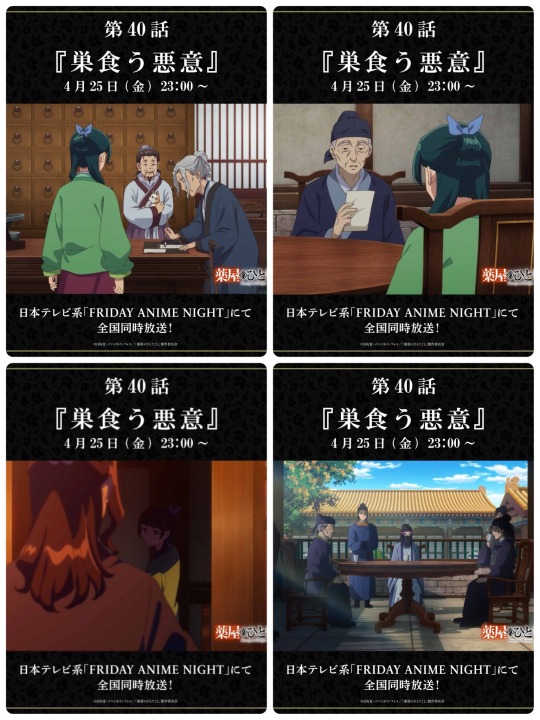
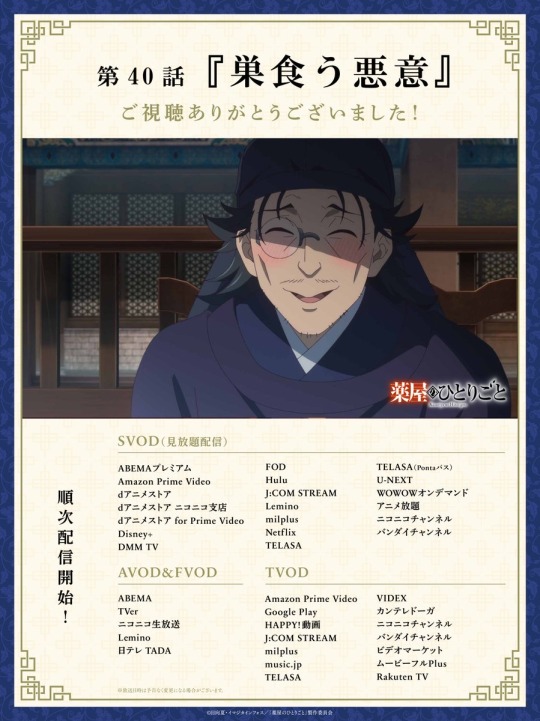
#apothecary english#apothecary romaji#the apothecary diaries#apothecary diaries#learning japanese#japanese#薬屋のひとりごと#薬屋のひとりごと 英語#薬屋 英語 学習#japan#KNH#season 2
4 notes
·
View notes
Note
I would like to see the gentle femdom list
ok this is an incomplete list of toku ships that I think have gentle femdom potential. or perhaps not so gentle
mako/takeru
nagi/komon
tsukasa/sakuya, tsukasa/keiichirou
tetom/silver
I think I’m the only person who ships this but I want sawa to top sento
megumi/wataru
maya/otoya, maya/nago
ozawa/hikawa OF COURSE
I’m looking at my shipping chart and it says shuki pegged zanki so I guess shuki/zanki
sakura with every male boukenger
kiriko/chase
umeko/sen
sayo/takamichi and sayo/shiguru
himeno/yanma and himeno/gira
yua/fuwa
ahim/gai, ahim/don, probably ahim with the other two guys as well
akiko/terui
nanaha/jin
13 notes
·
View notes
Text
2-3.12.2023
Miałam znów sen o jakieś wycieczce
Aczkolwiek co do reszty dnia mam jakiś zanik pamięci
Czy to przez gorączkę czy zwyczajnie wczoraj nic się nie działo ?
Nie wiem. Pamiętam jedynie że zostałam w domu właśnie z powodu gorączki i że do kogoś dzwoniłam na chwilę i że wieczorem napisałam do kuzyna z którym dawno kontaktu nie miałam i się umówiliśmy na przyszły weekend. Też oglądałam ponownie serial na netflixie pt
"Gambit Królowej"
Kiedyś mi poleciła to moja była terapeutka
Ten serial bardzo mi się podobał więc postanowiłam obejrzeć go po latach ponownie
Jest o dziewczynie co była królową szach. Zaczęła grać w szachy w piwnicy będąc w sierocińcu,pod wpływem pigułek zaczęła widzieć na suficie szachy i przez to była mistrzynią bo wiedziała jak grać
Na tik toku znalazłam filmik o tym jak wyglądają normalne,depresyjne i maniakalne oczy. I wychodzi na to że mam maniakalne. Maniakalne źrenice są poszerzone jakby było się pod wpływem jakiś narkotyków.
To już wiem czemu mam tak poszerzone
Tymbardziej jeśli teraz mam albo mieszane albo hipomaniakalne lub i maniakalne
Nawet po moich oczach widać manie 😐
Moja mama mi często od miesiąca zwraca nawet uwagę na to że mam poszerzone źrenice
W nocy coś mnie tknęło że miałam ochotę się pociąć i myśli samobójcze.
Nienawidzę stanów mieszanych bo jednak wtedy jest tak... Dziwnie
Mam wtedy euforie,dużą pomysłowosc ale i myśli autodestrukcyjne i samobójcze
Takie kocham życie i siebie ale chce się zabić 🙄
Nie mam kontroli nad tymi myślami ani stanami
A niedziela to moja Kiara mnie obudziła bo musiałam wcześnie wstać bo wybierałam się z mamą na giełdę po buty
I zaczęło sypać 😍




I kupiłam sobie buty. Złote śniegowce
Akurat pasowały tylko paradoks jest taki że w tych butach jest mi gorąco 🤣

Mimo że to są buty na teraz to mi w nich gorąco
Po powrocie z tej giełdy czytałam sobie książkę i wiecie co mnie dziwi ? Miałam wysoką gorączkę a umiałam być bardzo skupiona na tej książce
A co mnie jeszcze bardziej dziwi ? Że ta książka mnie nie striggerowała bo jest o zaburzeniach odżywiania
A dokładniej o dziewczynie co przez stresy zatraciła się w odchudzanie
Normalnie to mnie pod ten temat książki czy filmy czy artykuły ostro triggerowały a tu coś się stanęło że nie
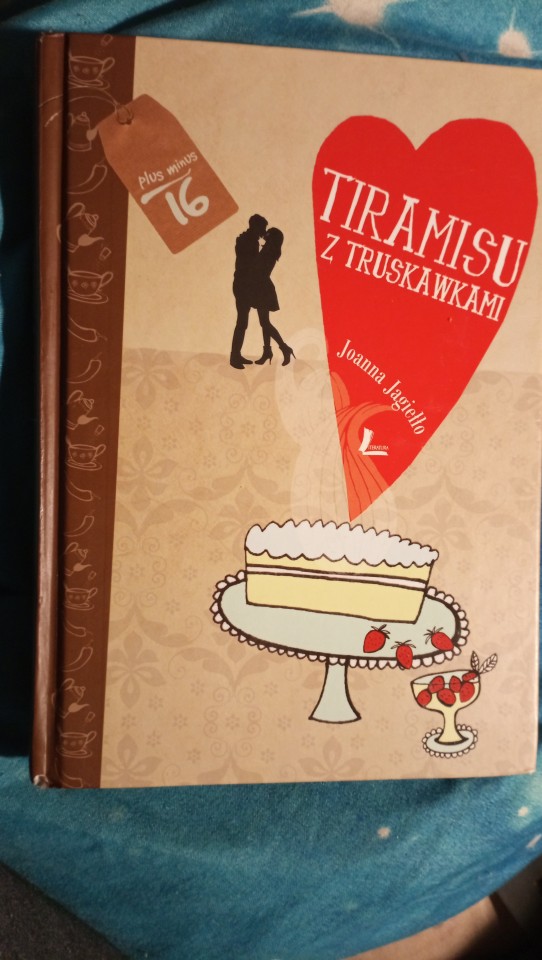
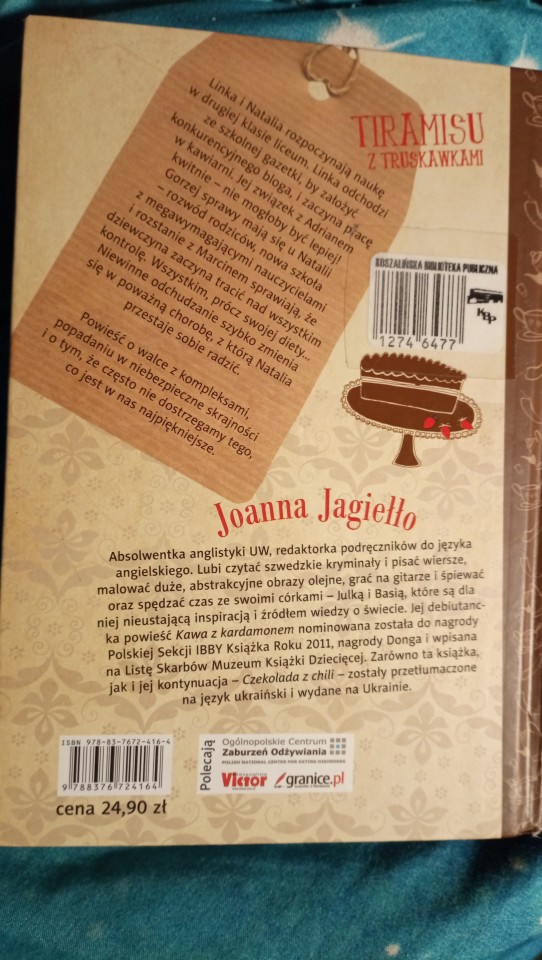
Jeśli ktoś by chciał przeczytać to zachęcam. Bardzo mnie wciągnęła aczkolwiek nie było takiego szoku jak po jednej
Odnośnie właśnie zaburzeń odżywiania
W ogóle tak się przyznam i jednocześnie sama się sobie dziwię
Moje pobyty w szpitalach w tym roku uświadomiły mi jak bardzo byłam więźniem własnej wagi
Mimo że te pobyty trwały po tydzień to jednak zdziałały w tym kierunku sporo
To były moje pierwsze razy bez ważenia i normalnego jedzenia. Często też nie liczenia kalorii
I wtedy czułam najpierw lęk a potem wolność
Wolność którą mi trudno opisać
I ja dosłownie bardzo bardzo długi czas byłam uzależniona od tego ważenia się
Ważyłam się w najgorszym okresie po głupim łyku wody
A teraz mimo że powinnam zrobić u siebie ważenie w niedzielę jak co tydzień to jednak tego nie zrobiłam
Ostatni raz się zważyłam jak wróciłam ze szpitala psychiatrycznego
Jak zobaczyłam że mimo normalnego jedzenia i picia i małej ilości ruchu spadłam pół kilo to postanowiłam teraz zrobić taki eksperyment
Zważe się dopiero na nowy rok
Jak schudnę to wyjdzie że ostatnio nie chudłam nie przez to że za dużo czy za mało jem tylko przez te jakąś presję że "muszę schudnąć,nie mogę przytyć"
A teraz tej presji nie ma bo sobie jej nie stawiam
Boże jakbym któregoś dnia poszła do dietetyk to by się chyba zdziwiła bo "wreszcie się udało"
Ale naprawdę będąc w tym psychiatrycznym ostatnio to ostatecznie powiedziałam sobie że chce dłużej te uczucie wolności
Ogólnie jak musiałam wyjść po pomidory i jakieś artykuły spożywcze to jak wróciłam okazało się że mam prawie 41° gorączki
To dlatego tak niemrawo się czuje i że zemdleje zaraz i mam omamy xd
Był potem w telewizji
"Grinch świąt nie będzie"
Jakiś trudno mi było się skupić na tym filmie.
Możliwe że przez gorączkę
Trochę ją zbiłam lekami przeciwgorączkowymi i lodowym kakao i jedzeniem yoghurtów z lodówki i witaminami do rozpuszczenia z lodem
No i plus jakieś zdrowe kanapki
Trochę pomogło bo o północy miałam już 38
A teraz to już w zasadzie 37 więc chyba do rana wydobrzeje
Jedynie co mi dołączyło to katar ale to na luzie przejdę
Tylko dalej mi gorąco xdd
Wieczorem dokańczałam obraz ale muszę jeszcze zrobić drobne poprawki i chyba jutro pokaże
I jeszcze podczas kończenia ktoś do mnie zadzwonił z kim bardzo chętnie porozmawiałam
O 1 oglądałam "Szpital" a później "Śmierć na 1000 sposobów"
Dziwne ale polubiłam oglądać programy które oglądałam jako dziecko
I tak się teraz zastanawiam nad tym co będę teraz czytać
Dziś też się wybiorę do biblioteki i muszę zajść do szkoły podpisać te deklaracje maturalne. Potem spytam o praktyki i zapisze się na wizytę do psychiatry. A potem terapia
I nie czuje się zmęczona mimo iż dopiero zbiłam gorączkę
Także ten do zobaczenia
Trzymajcie się kochani 💜
4 notes
·
View notes
Text
having a sunday brunch thought but it's interesting to see the splash back against pow/er rang/ers due to the (sigh) problematic nature of taking a Japanese media and whitewashing it. like true. no buts there. it's just that even for the stereotypical ways some Black characters were portrayed, i did fall for the representation as a kid. it did help to remind me that yeah other ppl do want to see us involved (where it takes certain tokus/atsu several years to have a Black hero, have them transform off screen, then kill them off...from what i've heard tbf). so i still have some lingering affection(?) for it. but the current 'po/wer ran/gers bad, sen/tai superior' is a different and way less gatekeep-y version that should be acknowledged as...right
po/wer ran/gers should have been more of its own thing inspired from super se/ntai from the start. it should have had a lot more Japanese actors involved at the very least. when super se/ntai was inspired by Spi/der-man they didn't just straight up have the spid/ey suit, they changed the bug (silence arachnophilliacs i know) or didn't have a bug at all but 4 other ppl, they changed the suits. pr didn't do that because it was cheaper to just copy and paste, it's almost a hand-me-down. and lets be real a good chunk of pr seasons aren't written that great bc for many reasons US execs have less respect for their younger audience than Japanese ones do
so when i see the Blu/e Bee/tle movie, that's what convinced me that maybe pr, as it is, was a mistake. not the hate creeds of sen/tai fans on social media. but the fact that it could have gone full circle in the funniest way possible
#waffle blather#yeah i'm censoring sen/tai and pr fans are scary as shit lol#this ramble is the most ramble ever#there is no proper conclusion lmao#what does this even mean
2 notes
·
View notes
Text
Characters introduction >>> built up to mysteries and characters’ conflicts >>> mysteries revealed and characters making mistakes (or abused by the plot in Neon case) >>> characters resolving their problems and earning their redemptions (or gaining second wind in Neon case).
I disliked Jitt’s nasty personality. But I liked his fighting style, both inside and out of suit. It reminded me of Ong Bak or Garo. His glaring expression was also charming.
I hoped there would be more toku show with Jitt’s fighting style.
Other villains brought the end of the world for sake of ruling it. DGP staff brought ruin to the world for the sake of viewer rating.
Taka-sen’s shows often contained reality subtext. Is there a case in real life where people do harm (either to themself or to others) for the sake of gaining more viewers?
4 notes
·
View notes
Note
Hello! Your secret valentine here once again! I've looked over your currently watching and noticed that you're watching a few toku series right now. I've watched some toku series and really enjoyed them, so I was wondering if you could tell me about your favorite toku and some characters or relationships that stand out to you. I'd love to hear your thoughts :)
hiya! yeah i've been rewatching some early 2000s sentai with my sister since we never got to finish them as kids. it's been so much fun rediscovering my love for the franchise and i owe it to the toku fandom on tumblr honestly. 🥰 it'll take me a while to catch up on everything that's aired, but i do plan to keep up with the franchise from here on out!
it's hard to pick a favorite since each series means something to me. and i've experienced some of them in two completely different stages: my younger self, who just loved the suits and action, and my current self, who has more exposure to japanese media. then there are series like boonboom and gavv which im only watching as an adult. so, i have no idea how to rank them in my heart, but i can tell you my impressions!
TLDR: gao nostalgic, hurri peak, deka objectively good, aba guilty pleasure, magi i don't remember, bunbun cute, kr geats peak, kr gavv indifferent
gaoranger: this was my first sentai ever, so i'll always have a bias towards it. i remember the kids in my neighborhood would always gather to roleplay the characters, and i would proudly claim to be gao white. there's something about her that feels so feminine and youthful 🥰!!! i definitely need to rewatch this series soon to see if i still love her the same. i have a feeling she'll still be my favorite female ranger! the animal mechas were so versatile! my memories of the episodes are mostly hazy, but i don't think i was ever that impressed by their friendship and teamwork. the group just always felt like a bunch of randos who just happened to come together for a cause, but they were likeable characters!
hurricanger: it's rare for me to care about every character equally, but this series made it happen! (well, minus ishuu because he got the least character development, but i promise he was lovely!) the entire cast was so so so charming, even down to the villains--i swear they were the stars of the show just like the rangers! i rewatched this as an adult last year, and i still loved it just as much, if not even more. the (b)romance between yosuke and ikkou altered my brain chemistry forever. shurikenger is the guy of all time. i don't know if you've watched hurricanger but you just had to be there for shurikenger!!! he's the lad! and evil bosses wendinu and furabijo? always a treat whenever they were on screen. i literally have no bad things to say about this sentai 😭
dekaranger: this is where my younger self and older self completely diverge. as a kid i thought the cop aesthetic was boring. i actually preferred the power rangers adaptation of it which had a bit more grit. but now, having rewatched deka as an adult, i consider it to have the best writing out of all the sentai i've watched. there was not a single dull episode. the writing was just the right mix of comedic and serious moments. my favorite characters are sen and tetsu (silly boys you will always have my heart), but honestly you could pick anyone from the team and they would be my favorite too. they all have very solid character development and backstories. the bromance between ban (red) and hoji (blue) was okay, not life changing but did reach my heart. the ONLY thing i don't like in this sentai is that the monsters didn't "enlarge" themselves after being defeated the first time. they instead hopped into giant robots which i thought was lame, but that's just me
abaranger: i am quite conflicted about this series. do i hold it dear to my heart and consider it one of my favs? absolutely i am always an abaranger defender. can i objectively say it was good? it was nowhere near that. the first 20 episodes had what i thought was my favorite kind of writing: punny and edgy. it did feel like they were subverting all the usual sentai tropes in the first half and i loved, i savored, i lived for every bit of it. but then came the second half it was consistently bad. some episodes were downright NONSENSICAL. despite all that abaranger still gave me ryouga who is my favorite toku character of all time :^) it always fills me with so much joy when the fandom calls him 'abaredad'! you just had to be there for his interactions with his "daughter" mai-chan. also, abarekiller, without potentially spoiling too much about his character, is the coolest mf.
kr ryuki, magiranger, ultraman cosmos (?): this was where i stopped watching toku and i honestly don't remember anything about them. i remember hating them when i was younger but who knows. i'm a different person now. will pick them up again in the very near future.
boonboomger: this was my first series after a loooong break from the franchise (well not really the first since i techincally started kr gotchard but dropped it so bunbun is what i considered my true comeback series). i am not sure if i'm used to the reiwa conventions yet. bunbun definitely feels tamer, less offensive, less violent than what i was used to seeing, but what’s keeping me engaged is the likeable characters. jou is quickly rising to my top favorite toku characters of all time--ily my silly guy. and i always have the best time when mira gets the chance to show off her driving skills!!! i am taking my time warming up to bunbun's charms and they're working! but maybe gritty is just more my vibe ^.^
kr geats: this could easily pass as a regular jdrama tbh, just without all the henshin. it had a more serious tone which i always look for in toku. loved the dynamics between the players and their investors (especially how they developed toward the end of the series!). ace is 100% in my top favorite protagonists (alongside ryouga from aba and yosuke from hurri?). every time he snapped his fingers to transform i nearly lost my mind. i enjoyed the friendship between keiwa and ace as well; i thought they had just the right amount of screentime together, nothing overstated, just... right. the only thing i didn't like was the god of genesis plotline.
kr gavv: it's still early for me to form a definite opinion on this series; im indifferent so far. i just know hanto is a silly guy that WILL rise to my fav list.
wow idk why i typed all that. i hope you only skimmed through it since i was just yapping. have a good day!! <3
0 notes
Note
Favorite Toku theme, insert and ending songs?
OOOOUOUOUAAAAAAAAA i'm going to TRY and narrow it down to a top 3 for each and also avoid season double ups for a nice spread
Intro themes
Dairanger theme is an absolute BANGER. Like its insanely good
Denziman theme for two reasons 1. Very good and 2. Wife can sing it with me
Changeman theme. Listening to it makes me want to watch Changeman and that IS the number 1 thing an intro should do tbhhhh
Insert themes (no robot or character songs included)
Go! Bababang! Go-Onger (go onger). Makes me exceedingly happy
1-2-3-4 Geki Seigi (gekiranger). The harmonica solo???? PLEASE.
Tatakai No Theme (sun vulcan) i agree. Lets fight. Lets fight.
Ending themes
WAKASA WA PLASMA (sun vulcan) ENDING THEME OF ALL TIME. I KNOW I SAID NO DOUBLE UPS BUT OH WELL.
Yusha Ga Yuku (battle fever) INAZUMA GA- its such a dramatic song for the most bat shit show its GREAT
Hadashi No Kokoro De (gingaman). Crying. Sobbing. Lying on the grass in the sun.
Just realised i accidently did all sentai so let me quickly mention:
Shi No Bi 88 - ending theme for Sekai Ninja Sen Jiraiya
Jouchaku Seyo! Gavan - a fight theme for Uchuu Keiji Gavan aaaaaaaand
Warera Omou, Yue Ni Warera Ari - intro theme for Kamen Rider Ghost 😌
3 notes
·
View notes
Text
Nampō Roku, Book 7 (70): Rikyū Said, the Two Mat Room with a Mukō-ro is the Place Where the Sō-an Lives.

70) [Ri]kyū continuously declared, “the two-mat〚room〛with mukō-ro, this was the first place where the sō-an [草菴] took up its abode¹. When the [naka-]bashira was erected, and the ro was relocated onto a different mat to the right [of the utensil mat], this was regrettable².
“From that [early two-mat room] -- this was [done] so that the guests would not feel so constrained -- [the room] increased to three mats, and then four mats³. Year after year, month by month, we have gotten used to doing various things [that were previously unknown]⁴.
“Then, because the size of the room [beside] the daime-tatami could be [manipulated] freely, many kinds of [new] arrangements also became possible⁵. And once various sorts of utensils [that had never been used before in the sō-an] came to be brought out, the effort [to realize the chanoyu of the sō-an] became futile⁶.
“If only things had [remained] as they were in the beginning, with nothing but the mukō-ro! -- since, despite how wonderful [these various innovations and modifications] might seem to be, they never should have been allowed to come into being. 〚[And] if things had remained just as they were, with but a single way to use the mukō-ro, no matter how delightful we might think [the different ways of doing] things are, having a great number of ways to do [the same thing] is wrong⁷.”
〚Time and again, we must reflect on our errors [and strive to do better], so it has been asserted⁸. We have to recognize [Ri]kyū’s unrelenting care and attention to [the realization of] a tea focused on sincerity and truth⁹ -- [because] such conscientiousness has [actually] been the norm since the earliest days¹⁰. It is through words such as these that we also may come to an understanding [of such things]¹¹ -- because a truly considerate chajin is someone who is worthy of praise! How very unfortunate [that such chajin are so few and far between today]¹²!〛
_________________________
◎ Like many of the preceding entries, the toku-shu shahon and genpon versions include comments that are absent from the Enkaku-ji manuscript -- and in the same manner as we have seen heretofore: the first sentence features certain (relatively minor) additions, with several new sentences (in this case, those covered by footnotes 8 to 12) added to the end of the passage. While the existence of different versions suggests that we are probably dealing with a kernel of truth that dates from Nambō Sōkei’s day in this entry, the idiom used by the authors in the present versions of the text also agrees with what we have seen in the similar instances earlier in Book Seven where multiple versions are found that parallel this one, suggesting that all of these sections were written (or edited*) and added to the collection of documents cached in the Shū-un-an by the same person, at the same time.
In the same way that I structured the earlier translations, the additional material from the toku-shu shahon has been incorporated into the above translation (enclosed in doubled brackets, in order to distinguish the additions from the original text). Variations found in the genpon version of the text have been largely dealt with in the footnotes. ___________ *All of the sections that exhibit this same pattern of sequential modification (all of which are restricted to Book Seven) appear to be based on material that had been preserved by Nambō Sōkei. Nevertheless, these passages seem to have been edited (most likely, to bring them into conformity with the teachings of the Sen family -- which is suggested by the Edo idiom that was used by their author) before being returned to Sōkei’s archive.
¹Kyū tsune ni no tamau, ni-jō mukō-ro, kore sō-an dai-ichi no sumai naru-beshi [休常ニノ玉フ、二疊向爐、コレ草菴第一ノスマヰナルベシ].
Kyū tsune ni no tamau [休常にの給う] means (this was) Rikyū’s constant way of speaking*.
Ni-jō mukō-ro, kore sō-an dai-ichi no sumai naru-beshi [二疊向爐、これ草庵第一の住居なるべし]: ni-jō mukō-ro [二疊向爐] means a two mat room with mukō-ro; kore sō-an dai-ichi no sumai [これ草庵第一の住居] means this is the primary† place where the sō-an lives; naru-beshi [なるべし] means (it) should be (like this).
Two versions of Rikyū’s two-mat room with mukō-ro are shown below.
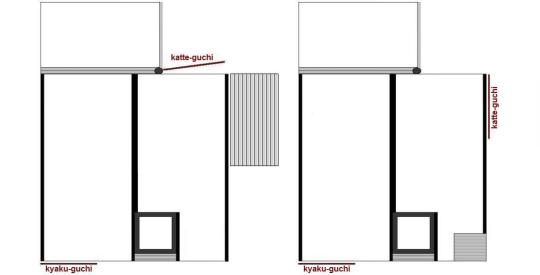
Shibayama’s toku-shu shahon has “Kyū tsune ni no tamau, ni-jō shiki kyaku-tsuke no mukō-ro, kore sō-an dai-ichi no sumai narubeshi“ [休常ニノ玉フ、二疊敷客附ノ向爐、是レ草菴第一ノ住居ナルベシ].
Ni-jō-shiki kyaku-tsuke no mukō-ro [二疊敷客附の向爐]: ni-jo-shiki [二疊敷] means a two-mat room‡; kyaku-tsuke no mukō-ro [客附の向爐] means the mukō-ro is cut on the side of the utensil mat closest to the guests. This is certainly more specific than what is found in the Enkaku-ji manuscript, but the Enkaku-ji manuscript uses forms with which we are already perfectly familiar (after progressing this far in the Nampō Roku), so the lack of specificity is not an issue (and so unnecessary).
The genpon abbreviates the first phrase to “Kyu no iu” [休ノ云], which means (what follows) was (something) Rikyū said. The rest of the sentence is the same as what was said in the toku-shu shahon version. __________ *More literally, Rikyū constantly bestowed (or pronounced) this (teaching) on (everyone with whom he came into contact).
This is an intentional exaggeration, one that was intended to suggest to the reader that Rikyū made an effort to promote the idea that the two-mat room was the origin of the sō-an. This is because, if we look at the documented history of chanoyu in Japan, the first rooms smaller than 4.5-mats were built in the spring of 1555 -- both of which were ni-jō daime [二疊臺目] rooms. The 2-mat room with mukō-ro is not mentioned until years after Jōō’s death (which occurred at the end of 1555).
Apparently Rikyū was looking back to an earlier time -- referring to chanoyu and the concept of the sō-an as these had existed outside of Japan (and probably to alluding to ideas that he encountered during his prolonged stay on the continent) for his precedent.
†Dai-ichi [第一] could also mean foremost or principal here.
It could even be interpreted to literally mean the first (place) -- as in that the two-mat room was the first place where the (idea of the) sō-an took up its abode: that is, the idea of the sō-an began with the guests moving into the 2-mat anteroom where the o-chanoyu-dana [御茶湯棚] was installed, and drinking their tea there (rather than waiting for it to be conveyed to them in the shoin).
‡Literally, ni-jō [二疊], which is what is found in the Enkaku-ji manuscript, means two tatami-mats. However, it is correctly assumed that this is referring to a room of that size. In Shibayama’s text, however, this fact is specified literally.
²Hashira wo tate, migi no betsu-tatami ni ro wo naoshitaru-koto kō-kai nari [柱ヲ立、右ノ別タヽミニ爐ヲナヲシタルコト後悔也].
Hashira wo tate, migi no betsu-tatami ni ro wo naoshitaru-koto [柱を立て、右の別疊に爐を直したること]: hashira wo tate [柱を立て] is referring to erecting a naka-bashira [中柱]; migi no betsu-tatami ni ro wo naoshitaru [右の別疊に爐を直したる] means to decide to relocate the ro onto the mat to the right (of the utensil mat); and -koto [こと] means the case or situation where these things were done -- that is, this is referring to the creation of the 2-mat daime room.
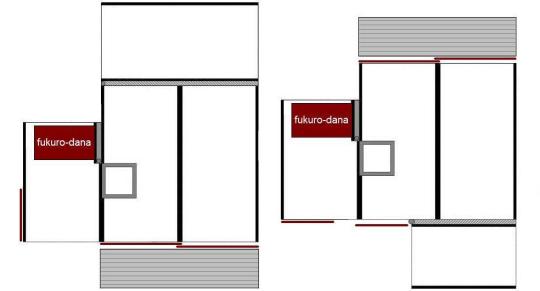
This sketch shows Jōō’s Yamazato-no-iori [山里ノ庵] (left) and Rikyū’s Jissō-an [實相庵] (right), the first two “small rooms” ever seen in Japan*, both of which were built in the spring of 1555. Note that in these rooms, while the fukuro-dana was still used (at least at first), it was completely hidden by the sode-kabe (which extended from floor to ceiling, making everything within the kamae invisible to the guests)
Kō-kai nari [後悔なり] means (the establishment of the 2-mat daime room) was regrettable. In other words, Rikyū is being quoted as having regretted, or been remorseful, that he and Jōō had decided (probably for the convenience of the guests†) to create the 2-mat daime room.
The other two versions agree with the text of this sentence. __________ *At least in so far as what we might call dedicated tearooms was concerned.
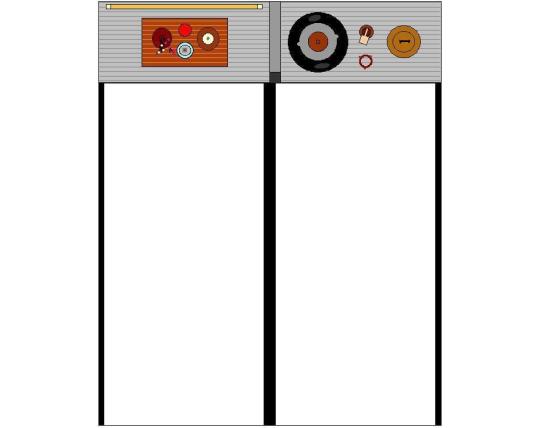
Shukō’s original Shukō-an [珠光庵] is said to have been a 2-mat room (with a walled-off, wood-floored recess -- originally a place to store things like bedding during the daytime -- that he used as if it were an o-chanoyu-dana when serving tea); but this was a monk’s residential cell, so its use for serving tea was occasional and temporary.
†Prior to that time, the only kind of room that had been used for wabi-chanoyu was the 4.5-mat room. If a group of guests had suddenly been invited into a two-mat room at that point in time, they would have been completely unprepared regarding where to sit and how to conduct themselves. The 2-mat daime room allows the guests to basically conduct themselves as usual, while reducing the overall space -- in particular, the space used by the host for the display and arrangement of the utensils.
³Sore-yori kyaku-seki no tsumanu-yō ni tote, san-jō ni nari, shi-jō ni nari [ソレヨリ客席ノツマラヌヤウニトテ、三疊ニ成、四疊ニ成].
Sore-yori kyaku-seki no tsumanu-yō ni tote [それより客席の詰まらぬようにとて] means from the early room, in order that the area used by the guests for their seats was not constrained (or useless)... -- that is, so that the guests did not feel boxed in.
San-jō ni nari, shi-jō ni nari [三疊になり、四疊になり] means (the room) became three-mats, four mats. This is referring to rooms of the following sorts.
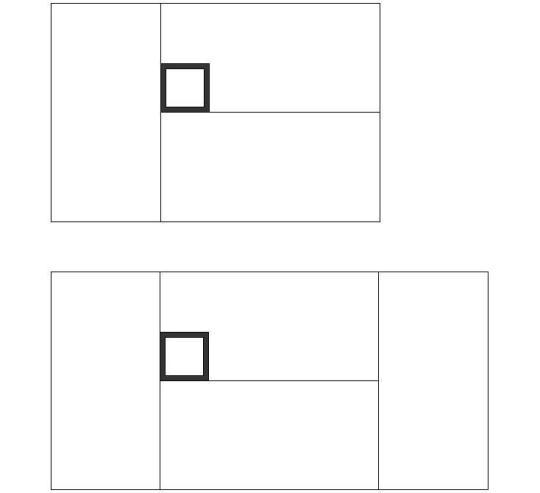
Because the original two-mat room would seem to confine the guests to too small an area, the room was increased to three mats, and then four mats. The details of these expansions have been discussed elsewhere in the Nampō Roku (both in Book One, and again in Book Seven).
While Shibayama’s toku-shu shahon reproduces the sentence as given in the Enkaku-ji manuscript, Tanaka’s genpon changes the ending, so that it reads san-jō ni mo, shi-jō ni mo nari [三疊ニモ、四疊ニモナリ] meaning that (in addition to the two mat room), rooms of three mats also, and rooms of four mats also, came into being. The basic meaning -- that the size of the room was increased in relatively short order -- is the same. ___________ *The reader may refer to the following posts for further information:
○ Nampō Roku, Book 1 (16): Regarding the Boards that are Inserted at the Far End of the Utensil Mat.
http://chanoyu-to-wa.tumblr.com/post/175652104074/namp%C5%8D-roku-book-1-16-concerning-the-boards
○ Nampō Roku, Book 7 (40): the Deep Three-mat Room.
https://chanoyu-to-wa.tumblr.com/post/702653075106742272/namp%C5%8D-roku-book-7-40-the-deep-three-mat
○ Nampō Roku, Book 7 (41): the Naga-yojō [長四疊] Room.
https://chanoyu-to-wa.tumblr.com/post/703015465673441280/namp%C5%8D-roku-book-7-41-the-long-four-mat-room%C2%B9
○ Nampō Roku, Book 7 (42, 43, 44): the Sketches for Entries 39, 40, and 41.
https://chanoyu-to-wa.tumblr.com/post/703287276430655488/namp%C5%8D-roku-book-7-42-43-44-the-sketches-for
⁴Nen-nen tsuki-zuki iro-iro no koto ni nareri [年〻月〻色〻ノコトニナレリ].
Nen-nen [年々] means year after year.
Tsuki-zuki [月々] means monthly, every month, month by month.
Iro-iro no koto ni nareri [色々] means we get used to doing various things (that move farther and farther away from the tradition established by Rikyū).
In other words the push away from Rikyū’s chanoyu was insidious*; it overwhelmed every trace of what had been there before.
While this sentence is the same in Shibayama’s toku-shu shahon, it is completely missing from the genpon version of the text. __________ *While this statement is very true, we must remember that this is not really talking about Rikyū’s actual style of chanoyu (which had already been all but forgotten), but the machi-shū tea (derived from the teachings of Imai Sōkyū) that was being championed by the Sen family. The second half of the seventeenth century was when the opposition to the Sen family (ironically, by the daimyō whose ancestors had been trained personally by Rikyū, and whose movement was technically intent upon repudiating Sōtan’s changes and restoring Rikyū’s chanoyu) began to reach fever pitch.
Unfortunately, this fledgling back-to-Rikyū movement was damned to failure on account of the fact that Rikyū’s densho (which were the only bridge between Rikyū and the chajin of the second half of the seventeenth century) were always written for a specific person, to answer that individual’s specific questions; and his answers were always predicated on the understanding that his correspondent already possessed. Thus, when the bakufu finally permitted the daimyō to restore the Rikyū-derived traditions that had been passed down within their families, their basic approach to the practice of temae had already been irreparably corrupted by their having been forced to imitate the manner of Sen no Sōtan for two generations, as much as by the fact that Rikyū’s densho are notoriously incomplete when viewed individually. (It was only possible to collate and summarize Rikyū’s actual teachings only after Suzuki Keiichi published his Sen no Rikyū zen-shū [千利休全集] -- in 1941 -- because that was the first time that all of the densho had been collected together, allowing them to be compared, and the blanks in one filled in with information that had been disclosed in one of the others.) The result was that, though the original idea had been to restore Rikyu’s chanoyu, this concatenation of circumstances meant that every daimyō moved off on his own tangent, as a consequence of the coloring of their pre-existing Sōtan-style chanoyu with a patina of only those Rikyū-based teachings that had been imparted specifically to their ancestor (while remaining largely, or wholly, ignorant of everything that had not been communicated, in writing, to that person -- since only the written word remained, while everything that had already been known by their ancestor, and so not mentioned by Rikyū in the densho that he wrote for that person, was long forgotten, suffocated under the unprecedented weight of Sōtan’s machi-shū tea).
⁵Mata daime-datami hiroku jiyū naru-yue, shu-ju no oki-awase mo dekiru [又臺目ダヽミ廣ク自由ナルユヘ、種〻ノ置合モ出來].
Mata daime-datami hiroku jiyū naru-yue [又臺目疊廣く自由なるゆえ] means because the largeness (of the room) of the daime (setting) could be (manipulated) freely....
In other words, because the number of mats that could be added to the right of the daime was free and unrestricted*....
Shu-ju no oki-awase mo dekiru [種々の置き合わせも出來る] means various kinds of arrangements were possible.
The toku-shu shahon and genpon texts add the word kazari [飾 or カザリ] before oki-awase [置合]. Oki-awase means the arrangement (the way the objects are placed out together on the mat); kazari oki-awase [カザリ置合] means the arrangement of the kazari. This has no impact on the English meaning (since the fact that it is the kazari that is being “arranged” is already understood from the context). __________ *This experimentation began with Sōtan's original room, which had just one mat to the right of the daime. As a result, the original Fushin-an [不審庵] was not a sukiya [数奇屋] because it failed to give the guests an unobstructed mat for their own use.
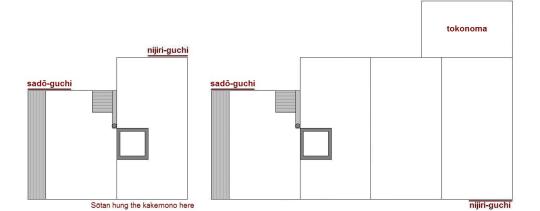
This is why, once the family became the prominent force in the world of contemporary chanoyu, Sōtan's son Kōshin Sōsa [江岑宗左; 1613 ~ 1671] added not just one, but two additional mats beside the mat in which the ro had been cut, making it an early example of the three-mat daime room.
Jōō’s Yamazato-no-iori and Rikyū’s Jissō-an, the first two daime chaseki, were, of course, two-mat daime rooms. They are illustrated under footnote 2, above.
Later on, even larger numbers of mats were added next to a daime utensil mat -- sometimes making the daime utensil part of a shoin-style room. These rooms are part of the corrupt trend that was discussed in the previous two footnotes.
⁶Sama-zama no dōgu wo tori-dashi, mu-yaku no koto ni narinu [サマ〰ノ道具ヲモ取出シ、無益ノコトニナリヌ].
Sama-zama no dōgu wo tori-dashi [様々の道具をも取り出し] means various sorts of utensils* were brought out (in these expanded versions of the daime setting).
Mu-yaku no koto ni narinu [無益のことになりぬ] means these reckless (variations) will not be of any use.
The reason for this being futile or useless is that the goal was to realize the chanoyu of the sō-an, and the introduction of the utensils and arrangements that had been created for the daisu-shoin setting is counterproductive†.
The second phrase of Shibayama's version is mu-eki no koto nari [サマ〻〻ノ道具ヲモ取出シ、無益ノコトナリ]. This means (bringing out various utensils) is futile.
There is no real difference between what these two variants are trying to say.
This sentence is completely missing from the genpon version of the text. __________ *The implication is that these various utensil combinations were never sanctioned for use on the daime, and are only being attempted because the rest of the room has expanded to the point where it is now for all intents and purposes a shoin.
†As this was the direction that chanoyu had taken during the Edo period, this entry is, at least in part, a protest against this trend.
⁷Hajime no gotoku mukō-ro bakari naraba, ika-hodo mezurashiki-koto wo subeki to omotte mo, naru-bekarazu to iu-iu [始ノゴトク向爐バカリナラバ、イカホドメヅラシキコトヲスベキト思テモ、ナルベカラズト云〻].
Hajime no gotoku mukō-ro bakari naraba [始の如く向爐ばかりならば] means “if, as in the beginning, only the mukō-ro was being used....”
In other words, if none of the other variants (such as the daime) had ever been proposed -- if the sō-an had been strictly limited to rooms where tea was made with a mukō-ro*....
Ika-hodo mezurashiki-koto wo subeki to omotte mo [如何ほど珍しいことをすべきと思っても] means “no matter how wonderful (diverging from the tea of the mukō-ro) might be considered to be....”
Naru-bekarazu to iu-iu [なるべからずト云々] means “it should never have been done.”
This is the end of the passage, as it is found in the Enkaku-ji manuscript.
The toku-shu shahon text, on the other hand, has hatsu no mama mukō-ro to hito-dōri naraba, ika-hodo mezurashiku-sen to omōte mo, amata no koto ha naru-majiki nari [初ノマヽ向爐一通ナラバ、イカ程珍ラシクセント思フテモ、アマタノコトハナルマジキナリ].
Hatsu no mama [初のまま] means just as in the beginning.
Mukō-ro hito-dōri naraba [向爐一通りならば] means even if there had only been one way (to use) the mukō-ro....
Ika-hodo mezurashiku-sen to omote mo [如何程珍らしく爲んと思うても] means even if you think (the variations are) extremely wonderful to do....
Amata no koto ha [數多のことは] means a great number of ways to do (something)....
Naru-majiki nari [成る間敷きなり] means (this) should not be done.
In other words, “even if, just as in the beginning, the mukō-ro had (always) been used in only the one (original) way, even if (the variations) seem wonderful, having many options is not appropriate.”
The argument here is not that it is the deviations from the mukō-ro setting that were problematic, but that numerous variations on the way to do things (with the mukō-ro), the various forms of the mukō-ro temae (each with its own secret rules, connected with specific utensils), is what is uncalled for. Rather than trying to come up with different ways to do things in order to “spice up” the gathering (as is often the rationale behind the many modern variations), people should content themselves with using the mukō-ro as it was originally intended to be used† -- since the purpose of chanoyu in the sō-an is to prepare and share a good bowl of koicha, so the most expedient way of doing that is best.
For this reason, I decided to include this version at the end of the paragraph, even though it, to a large extent, repeats what has just been said in slightly different words (that produce a different meaning), with the text enclosed in doubled brackets.
The genpon text includes this version of the sentence. __________ *When the ro was first introduced (in the 4.5-mat room setting), Jōō’s intention was that it should have been used all year round.
The same idea appears to have been in the back of Rikyū’s mind, regarding the two-mat room with mukō-ro.
That is why rooms with a ro were considered sō-an -- because they did away with the elaborate trappings (the costly metal furo, or even one made of clay, and the various ways of arranging the room that this utensil demanded).
The first time a furo was used in the small room (in 1586) was when Rikyū created the Yamazato-dana [山里棚] for Hideyoshi to use when serving tea in his Yamazato-maru [山里丸] -- the two-mat room in the boathouse on the moat within Hideyoshi’s Ōsaka castle compound. The purpose was, like with the daisu, to have everything already ready in the room, so that Hideyoshi could enter, simply serve tea (without having to go back and forth from the temae-za to the katte bringing things out) while talking with his guests, and then leave with them (without having to empty the utensil mat afterward).
The first time a furo was used in the small room in a public setting (the guests visiting the Yamazato-maru were, of course, Hideyoshi’s intimates) was when Rikyū did so in the two-mat room he constructed within the tea village in the pine-barren that surrounded the Hakozaki-gū in 1587. That room featured a mukō-ro; but when Rikyū wanted to use the small unryū-gama in that setting (perhaps as a way to keep the heat to a minimum), he did so by placing the large Temmyō kimen-buro (that had been Nobunaga's treasure) on top of the closed lid of the mukō-ro -- causing the guests to comment that Rikyū had placed the furo directly on the floor. While Rikyū seems to have done this as a subtle way to reinforce the continuity between Nobunaga’s reign and that of Hideyoshi (a point that was still being doubted by some of the influential citizens of Hakata), both of these details were initially unnerving to the chain of that area, because they violated the recognized conventions. (Though, after thinking things through, they also opened up possibilities that had never been considered before -- and thus were imitated in quick order by the chajin of Hakata.)
†This accords with the criticism of the chanoyu of the capital mentioned at the end of the previous entry (in the genpon version of the text), that the chajin of the capital had become so caught up in the idea of doing things differently for the sake of making the gathering more interesting (and challenging -- since only the members of a small group would understand exactly what to do, while those who had studied with a different teacher might find themselves stymied) -- that they had completely lost touch with Rikyū’s (or, rather, the Sen family’s) teachings on the correct way to practice chanoyu.
The reader will notice a certain continuity of idiom between that entry (in the genpon) and the present one (as found in the same source) that confirms this interpretation of the relationship between these two passages.
⁸Kaesu-gaesu ayamachi to koso oboyuru to mōsare-shi [返ス〻〻過チトコソ覺ユルト被申シ].
From this sentence on to the end of the entry, we are considering ideas* only found in the toku-shu shahon and genpon texts. All of this material is missing from the Enkaku-ji manuscript.
Kaesu-gaesu [返す返す] means repeatedly, time and time again, again and again, over and over.
Ayamachi to koso [過ちとこそ] means precisely those mistakes (that you have fallen into repeatedly).
Oboeru to mōsare-shi [覺えると申されし] means it is said that (it is just those mistakes) on which you should focus your efforts (to eliminate them from your practice).
Tanaka’s genpon text has kaesu-gaesu ayamachi to koso oboere to mosare-shi [カヘス〰アヤマチトコソ覺レト被申シ]. The change means “(you) are urged to remember (i.e., look into) the mistakes to which you return again and again.”
While the wording is slightly different, the essential meaning -- that one should actively criticize one’s own temae, and take whatever steps are necessary to correct one’s mistakes -- is the same. __________ *Perhaps “admonitions” would be a better word for these dicta. The pedantic neo-Confucian tone that became more and more a feature of chanoyu instruction in the late Edo period (and beyond -- including in the modern day) is increasingly apparent in these added sentences.
⁹Kyū no kokoro-ire ha kure-gure magokoro-makoto no cha wo omoi-torite [休ノ心入ハ呉〻眞心眞實ノ茶ヲ思ヒ取リテ].
Kyū no kokoro-ire [休の心入] means Rikyū’s care and attention (to every aspect of the practice of chanoyu).
Kure-gure [呉々] means repeatedly, again and again, over and over.
Magokoro-makoto no cha [眞心眞實の茶] means that Rikyū’s tea was truehearted (absolutely sincere) and genuine (revelatory of the truth).
Omoi-toru [思い取る] means to realize, to understand, to be considerate of (something), to decide (upon), to make up one’s mind.
In other words, Rikyū was always careful that chanoyu be always and deeply concerned with sincerity and truth*.
The identical sentence is found in Tanaka’s genpon text. __________ *These remarks can be considered part of what we might call the apotheosis of Rikyū -- turning him from a devoted and dedicated practitioner of chanoyu into a superhuman tea kami whose purpose was to guide the tea community toward truth and sincerity. The remainder of the entry is intended to glorify him in the eyes of the reader.
¹⁰Kokoro-zukai arishi-koto [心遣アリシコト].
Kokoro-zukai [心遣い] means things like consideration, thoughtfulness, attentiveness, solicitude (being solicitous toward some principal).
Arishi-koto [在りしこと] means (this attitude of attentiveness) has existed since the early days.
The criticism seems to be that the mindless and formalistic way of practicing chanoyu is a recent aberration.
Once again, the genpon text includes the same sentence.
¹¹Kayō no kotoba ni te mo shiraruru nari [ケ様ノ言ニテモ知ラルヽナリ].
Kayō no kotoba ni te mo [斯様の言葉にても] means (it is) also through words of that sort (i.e., the ideas discussed in the previous footnotes).
Shirareru [知られるなり] means (this concept) is made known.
In other words, a chajin’s greatness can be known not only through descriptions of his doings, but also by contrasting him with the usual ways of the world.
Here again, Tanaka’s genpon source agrees* with the toku-shu shahon text. __________ *That said, the kanji used in Tanaka’s version are less ambiguous: kayō no kotoba ni te mo shiraruru nari [カヤウノ辞ニテモシラルヽ也].
Kayō [カヤウ] is a phonetic representation of the expression, while kayō [ケ様] is one of those weird written mannerisms that were so popular around the middle of the Edo period.
Likewise, kotoba [辞], which means language, words, expressions, etc., is clearer than kotoba [言] -- which, as a kanji, is more commonly used to refer to speaking or speech. Today the classical kotoba [言葉] (“the leaves of speech”) is, of course, preferred over these other two.
¹²Shinsetsu kidoku no chajin oshimu-beshi oshimu-beshi [深切奇特ノ茶人可惜〻〻].
Shinsetsu kidoku no chajin [深切奇特の茶人]: shinsetsu [深切] means things like kind, gentle, considerate, generous, and so forth; kidoku* [奇特] means to be worthy of praise.
Thus, someone who embodies the virtues that we have been discussing in the past several footnotes is a chajin who is worthy of praise.
Oshimu-beshi oshimu-beshi [惜しむべし惜しむべし] is a lament (the repetition gives added emphasis) -- that chajin of this sort are all but unknown in the contemporary world of tea. It would be translated by expressions like “how sad,” “such a loss,” “how unfortunate,” “how regrettable,” and so on.
This can also be interpreted as a specific lament over the loss of Rikyū -- since he clearly has been drawn as the personification of the ideal chajin.
Though the genpon text spells out the second phrase (oshimu-beshi oshimu-beshi [惜ムベシ〰], as opposed to oshimu-beshi oshimu-beshi [可惜〻〻] as found in Shibayama’s toku-shu shahon), the sentences are actually identical. __________ *Today, kitoku [きとく = 奇特] seems to be the preferred pronunciation.
3 notes
·
View notes
Text
Ksitigarbha sutra
にじせそん こうこんじきひ うまじぞうぼさつ まかさっちょう にさぜごん Ni jise son kō Kon jiki hi umaji zō bo-satsu makasa tchō ni sa ze go n じぞうじぞう にょしじんりきふかしぎ にょしじひふかしぎ にょしちえふかしぎ にょしべんざいふかしぎ Ji zōji zō ni ~yoshijinrikifukashigi ni ~yoshijihifukashigi ni ~yoshichiefukashigi ni ~yoshibenzaifukashigi この時、世尊は金色の腕を上げ、「地蔵菩薩は最高に偉大な志を持つ者です」と言った。 Kono toki, seson wa kin'iro no ude o age,`djizōbosatsu wa saikō ni idaina kokorozashi o motsu monodesu' to itta. 地蔵よ地蔵よ、汝の神力は無量である。汝の慈悲は無量である。汝の智慧は無量である。汝の分別は無量である。 Jizō yo jizō yo, nanji no Shinriki wa muryōdearu. Nanji no jihi wa muryōdearu. Nanji no chie wa muryōdearu. Nanji no bunbetsu wa muryōdearu. しょうしじっぽうしょぶつ さんだんせんぜつ にょしふしぎじ せんまんごうちゅう ふのうとくじん Shi ~youshijippoushobutsu-sanda n sen zetsu ni ~yoshifushigiji sen ma n go uchi ~yuu fu nō toku jin
例え、十方のもろもろの佛は教えをほめたたえ、汝の無量の境地は、無限に滅びることはない。 Tatoe, jippō no moromoro no hotoke wa oshie o home tatae, nanji no muryō no kyōchi wa, mugen ni horobiru koto wanai.
#not done#not anywhere near done#but its a start#Ksitigarbha sutra#its a wip#feedback appreciated#buddhism#mahayana#japanese
1 note
·
View note
Text
The results are in!
Amongst the participating voters, 83.7% have not seen Sekai Ninja Sen Jiraiya, with only 5.5% having seen it in full.
Jiraiya is the 11th "most slept on" toku (another installment + familiar percentages) and the 3rd most seen Metal Hero
Most Seen Metal Hero:
Space Sheriff Gaven the Movie - 26.7%
Juukou B-Fighter - 25% (12.5% finished)
Sekai Ninja Sen Jiraiya - 16.4% (5.5% finished)
Tokusou Robo Janperson - 12.9% (3.2% finished)
BLUE SWAT - 4.7% (0% finished)
B-Robo Kabutack - 0% (0% finished)
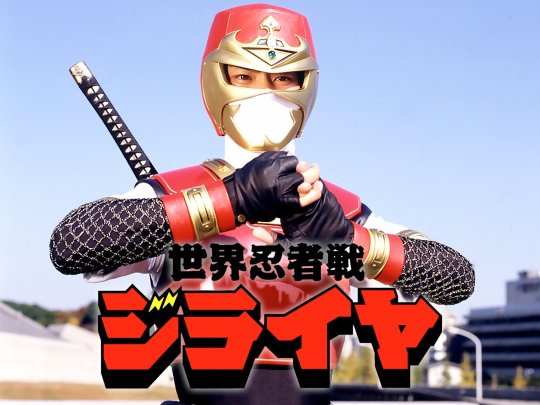
9 notes
·
View notes
Photo
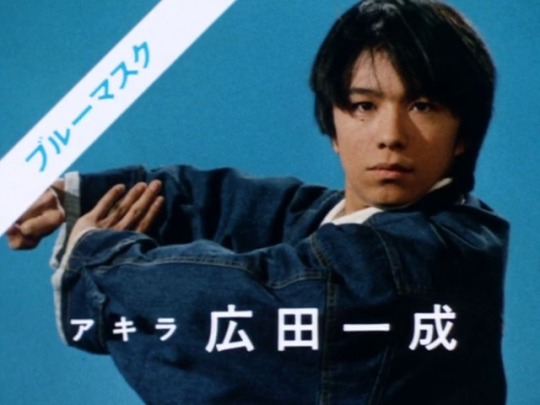



Actors with multiple roles in toku: Hirota Issei
Akira/Blue Mask (Hikari Sentai Maskman, 1987-1988)
Asuka Ryu/Spear Ninja Toppa (Ninja World War Jiraya, 1988-1989)
#Actors with multiple roles in toku#hirota issei#maskman#hikari sentai maskman#sekai ninja sen jiraiya
5 notes
·
View notes
Note
what do submarines and aircraft carriers look like? do they look like the regular ship mechas?
The submarines’ appearance may change depending on their class (Typhoon class, Vanguard, Delta III, 092 Xia etc). However, all of them in general have a “bulkier” appearance.

This one is Dmitriy Donskoy TK-208, a Typhoon/Akula class submarine!
As for aircraft carriers, there are both normal aircraft carriers and submarine aircraft carriers.

This one is a submarine aircraft carrier, I-402 Sen Toku. Normal carriers look less bulky!
their faceplates have different shapes as well:

Aircraft carriers look a lil sharper, while submarines are a lil rounder and smooth =w=
67 notes
·
View notes
Photo

Who wants to talk about Ninja?
Months ago I discussed a want to get into the metal heroes series. So keeping with that, today's stream will start with a watchalong of Ninja World War Jiraiya.
5pm CST. Hope to see you then.
twitch.tv/megiddo_ichi
twitch_live
1 note
·
View note